Веера. Antique fans.17-19 c.Часть 2
Веера.17-19 век.Antique fans.Часть 2.
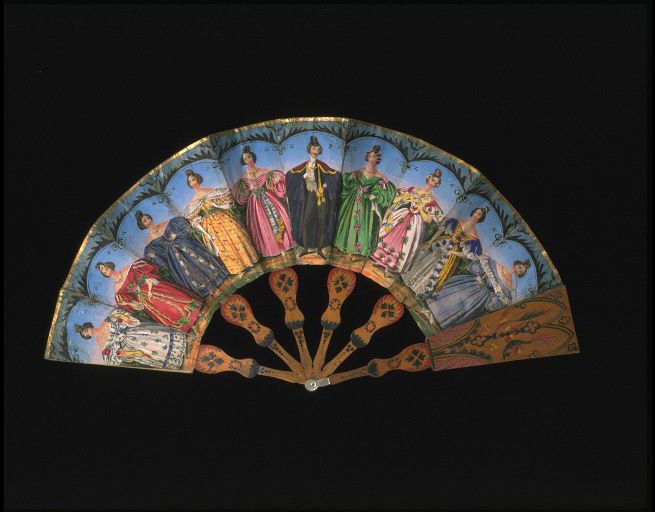
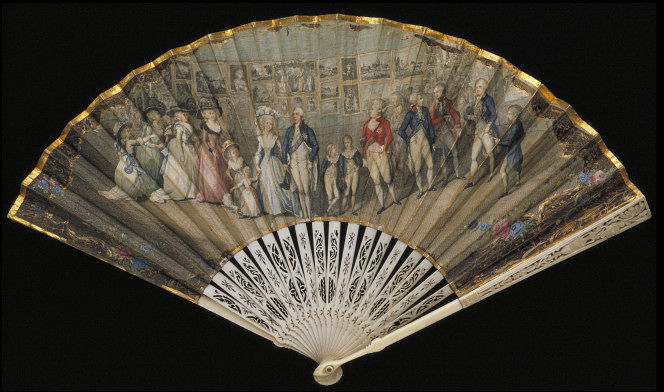
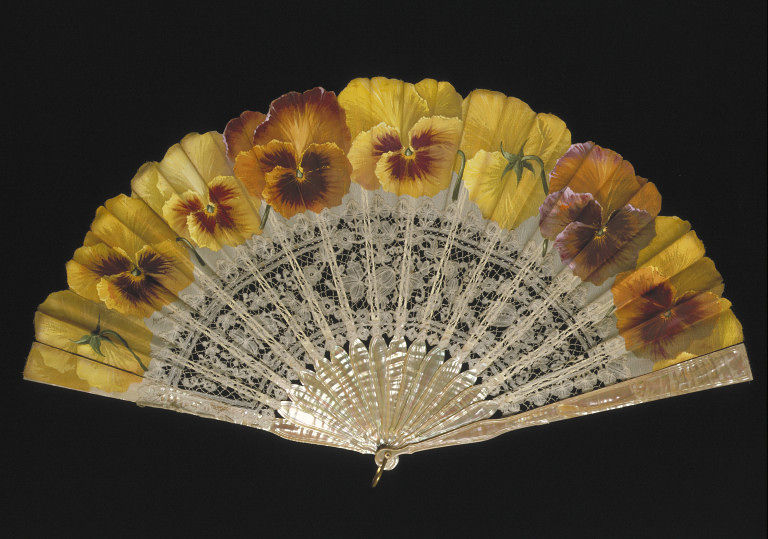
В этом посте, в основном- очень редкие расписанные веера с разнообразными сюжетами из музея Виктории и Альберта.
Сюжеты очень интересные- от мифологических до бытовых, (те, кому трудно читать по английски, могут загрузить линк на пост в гугл-переводчик:http://translate.google.ru/#)и читать сразу все интересные описания.
====================Веер в истории========================
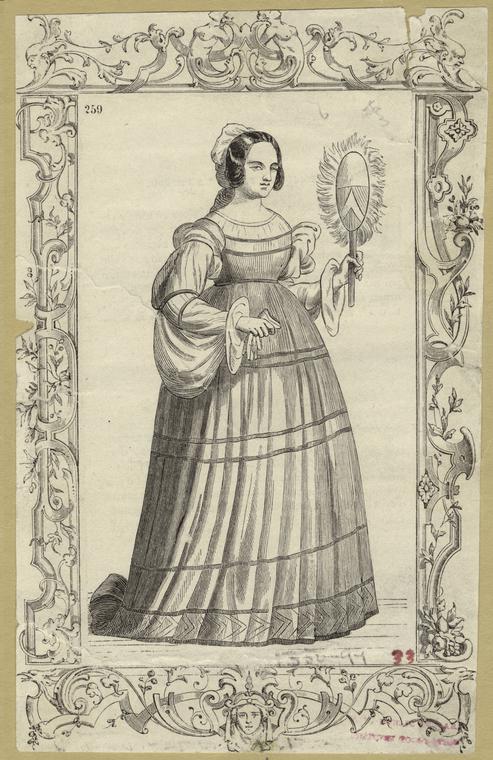
Woman holding a fan, Spain, 14th century

Veiled woman holding fan, Turin, Italy, 16th century.
Первые складные веера были завезены в Европу португальскими купцами из Японии и Китая. Как ни странно, свое триумфальное шествие по Европе модная восточная диковинка начала из Ватикана, с которым португальцы имели торговое соглашение. Сами итальянцы уже в XVI веке достигли больших успехов в изготовлении вееров. Даже большие живописцы не чуждались этого, казалось бы второстепенного, жанра. Братья Караччи, по некоторым сведениям, расписывали веера на вилле Монсиньори близ Болоньи, а Доменикино (1581-1641) создавал рисунки для экранов.
Во Франции складной веер распространился благодаря королеве Екатерине Медичи (1519 - 1589) - племяннице папы Льва X. Именно она привезла во Францию различные предметы роскоши - духи, перчатки, носовые платки и веера, среди которых были и складные. Их можно видеть на картинах, изображающих «Бал по случаю свадьбы Герцога Жуаёза» (1581) и «Бал при дворе Валуа» (1582).
В конце XVI века из Франции складные веера проникли в Англию. Королева Елизавета I на своих поздних портретах часто изображалась со складным веером в руках. Складные веера среди прочих упоминаются в описи гардероба, сделанной после ее смерти.

French woman holding a fan, 1780s

French woman holding a fan, 1780s

French woman holding a fan, 1780s

Women standing with fan and hat, France, 1814
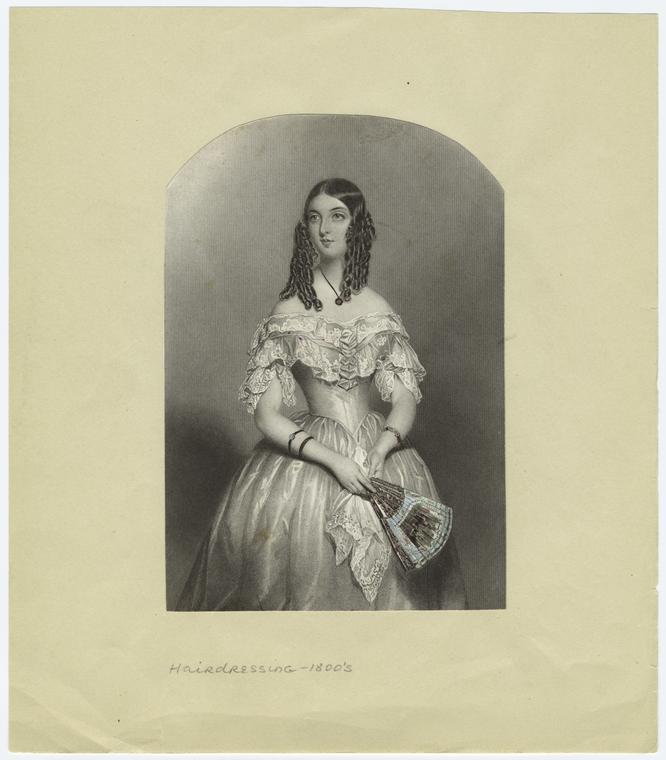
Young woman with curled hair holding fan, 19th century

1859
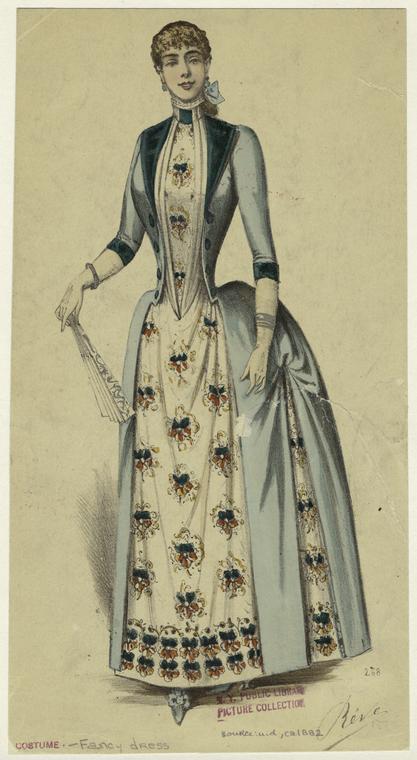
1870

Evening toilettes. (1883)
==============================================
-------------------------Бризе-------------------------
Brisé fans have no fan leaf and are comprised of fan sticks held in place by a silk cord or ribbon. The sticks are often decorated by extremely intricate piercing and carving, creating an illusion of filigree work or lace. The sticks on this fan, with their serrated tips, display a strong Chinese influence. Many fan sticks were produced in China for import into Europe.

Unknown
Очень редкий веер 17 века- итальянская соломка
1620 Соломка и страусиные перья
==========================================
Cкладной веер, разделяется на два вида.В русской терминологии нет аналогов европейскому названию такого вида веера, в европейских языках он называется веером «бризе», согласно принятому во всех языках названию от французского «brise» - складной или ломанный. К первому относится веер, состоящий из пластин и экрана, а ко второму - из одних только пластин.
В российских изданиях части веера называются порой совершенно по-разному. Единственным исключением является лишь название самого листа - экран. В XIX столетии он назывался «покрышкой» или «листом», и лишь с XX века стал «экраном». Материал для изготовления экрана мог быть самым разнообразным, но чаще всего использовалась бумага, пергамент (отлично выделанная телячья кожа), шелк и кружево.
Каркас, на котором закреплен экран,
-в российской терминологии наименование этой части веера постоянно менялось. В XVIII столетии обходились терминами «полоски» или «кости». В начале XIX столетия веер описывают как «тонкую кожу или кусок бумаги, тафты или материи, обрезанной полукругом и укрепленной на многих стрелках или маленьких весьма тонких палочках из дерева, слоновой кости, черепаховой чешуи, китовых усов или тростника. Сии стрелки, довольно обыкновенно называют опахальными палочками, все соединены нижними концами и нанизаны на маленький металлической прутик, закрепленный с обоих концов».
-----------------------------
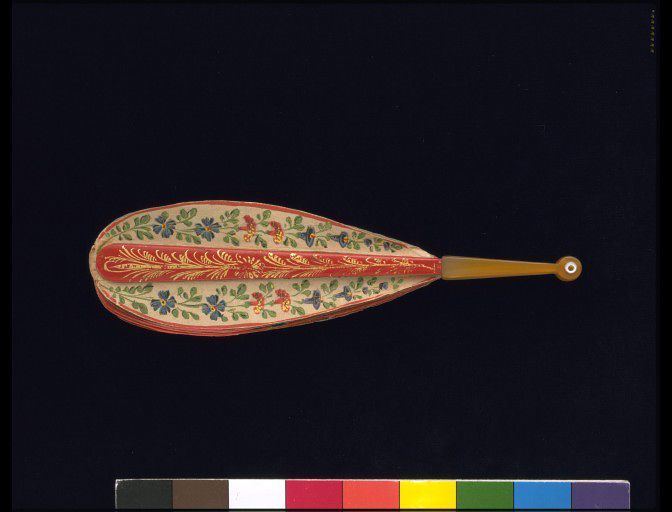
Brisé fans have no leaf. They are made of sticks held together with a silk cord or ribbon. This brisé fan imitates the shape of feathers, with silk-covered sticks brightly painted in gouache. Flowers, exotic birds and insects adorn the fabric. The use of real feathers in fans became popular from 1875. This reflected the growing variety of fan shapes and materials during the 1800s and the fashion for novelty in accessories.
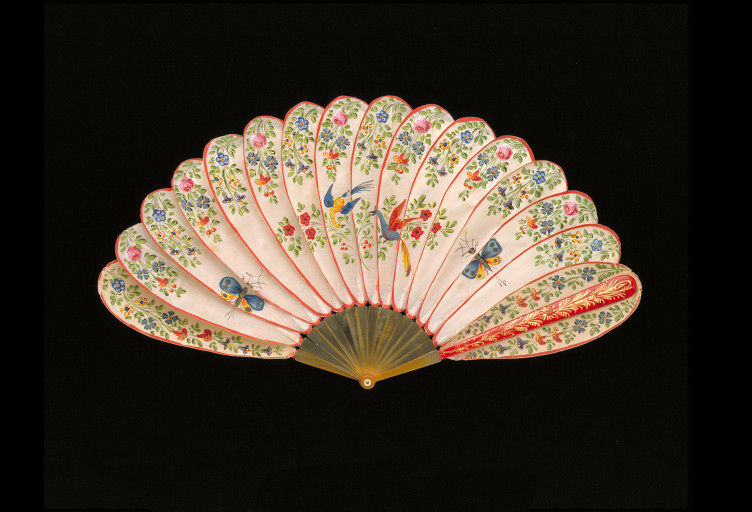
1820-1840 (made)
---------------------------------------

Перламутр, пронзили, резьба, золочение
mid 18th century

В 1870-х и 1880-х, многие веера и платья были сделаны из одной и той же ткани.
----------------------------------
Оправой называли остов и во второй
половине XIX века. Количество пластин менялось в зависимости от угла разворота веера.
Особое название имеют лицевые пластины остова, или две крайние пластины, которые закрепляют экранный лист. В начале XIX века они назывались «конечными стрелками», которые «делаются крепче прочих и наклеены на бумаге, которая их покрывает, когда опахало сложат. Они украшаются, смотря по красоте и цене опахала». Во второй половине XIX века они назывались «наружными пластинками» или «ручками».
Остальные части остова как правило, сделаны из того же материала, что и лицевые пластины, а иногда из материала, отличного от них (особенно в случае, если лицевые пластины выполнены из драгоценных металлов). В верхней части (на которой собственно крепится экран) они могут быть закрыты, если экран выполнен из двух сшитых или склеенных листов, а могут быть видны с оборотной стороны веера (при так называемой английской монтировке - monture a l'anglaise). Иногда они располагаются на лицевой стороне экрана - такая монтировка называется «a la sultane».
В нижней части остова пластины объединяет соединительный штифт, иногда внизу веера, между головок соединительного штифта закреплено кольцо, к которому привязывается кисть или прикреплена цепочка.
------------------Расписные-----------------------
----------------------Fan leaf---------
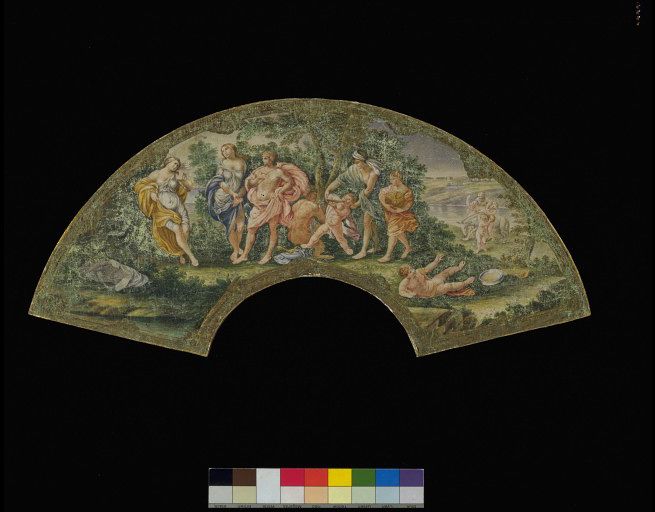
Fan leaf
The scene is copied from a sketch by the artist Guido Reni (1575-1642)
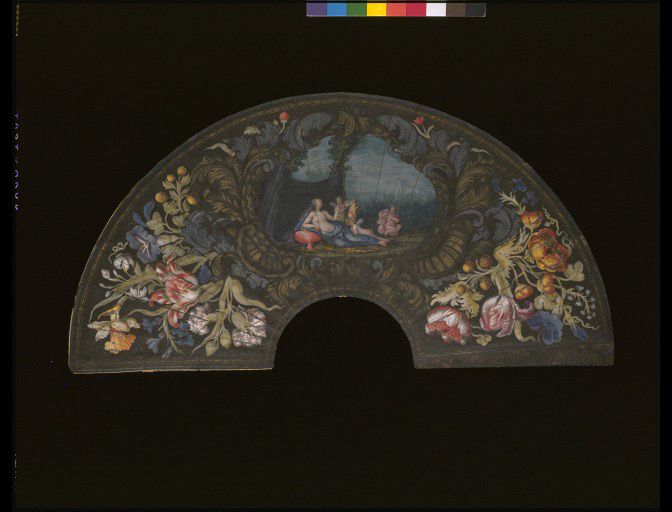
1670-1680 (made)
The central cartouche of this fan leaf depicts Venus. She is attended by putti holding symbols of love. One supports a shield with a pierced heart, representing ‘love conquers all’. Another holds a bow and feels the point of an arrow. In the distance is a lake with several swans, birds also associated with Venus.
----------------------------
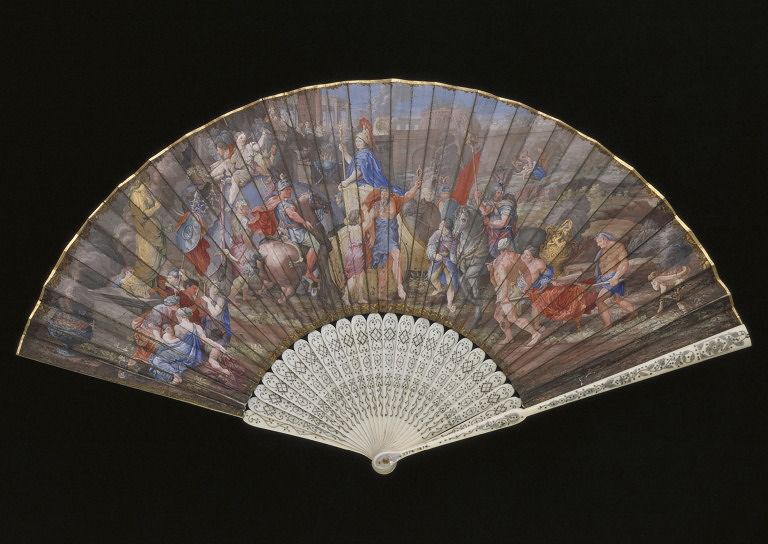
Триумф Александра
1670-1700 Италия
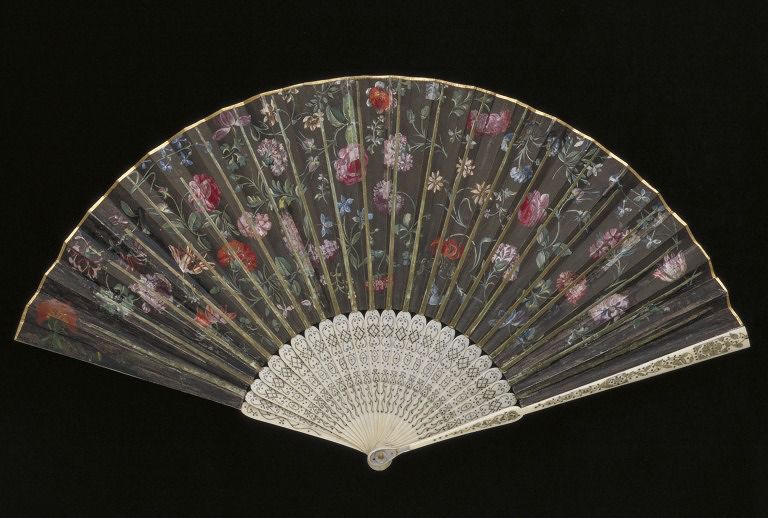
иллюстрирует "Триумф Александра", когда Александр Великий вступили в Вавилон. It is taken from one of a set of five paintings Charles Le Brun created for Louis XIV between 1661 and 1668. Он взят из одного набора из пяти картинах Шарль Лебрен, созданный для Людовика XIV между 1661 и 1668.
-----------------------------------
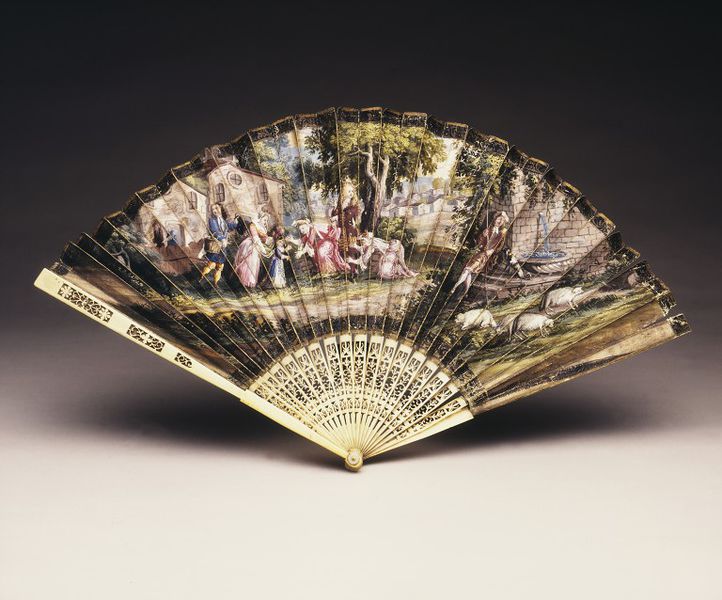
>
Unknown
1690 Кожа, расписанные гуашью, и слоновой костью
Это редкое конце 17-го века вентилятор внутреннего изображает сцену в пастырской обстановке. The little boy or girl is in a child's dress, specially equipped with tapes from the shoulders to steady the child when learning to walk. Мальчик или девочка в платье ребенка, с лентами от плеч - учиться ходить.
--------------------------------
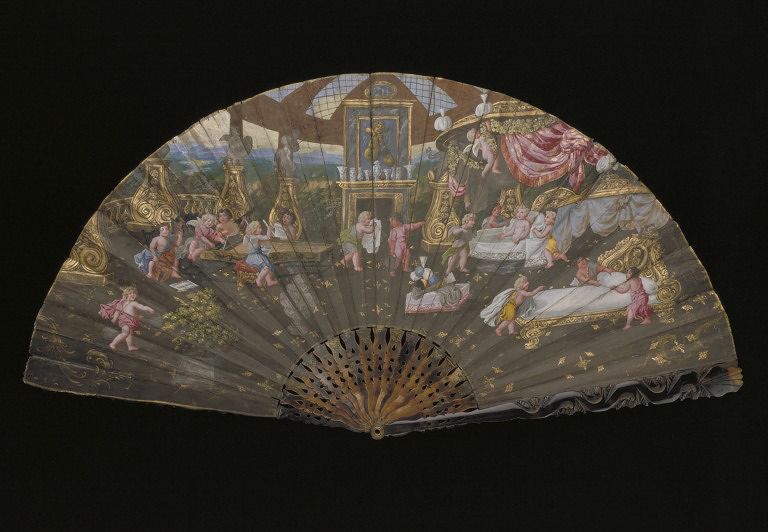

'Туалетная "описывает процесс одевания. It was a popular subject for a fan leaf in the late 17th century, as this example shows. Это была популярная тема листа в конце 17 века, как видно из этого примера. A large and opulent chamber opens on one side with a view of a distant landscape behind. Большие и роскошные палаты открывается с одной стороны, с видом на далекий пейзаж позади.
----------------------------

Unknown
1670-1700
This fan depicts the storming of Jerusalem during the First Crusade in 1099. In 1096, a large army from Western Europe was raised by fervent preaching to re-establish Christian rule in the Holy Land of Palestine, then governed by Muslims.
---------------------
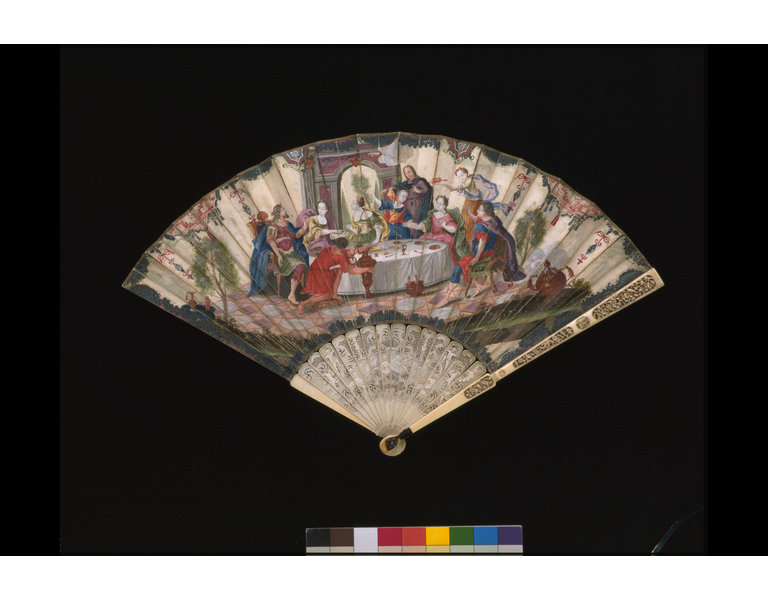
The fan depicts Belshazzar's Feast, a story from Old Testament Book of Daniel which tells how the Babylonian king Belshazzar profaned the holy vessels taken from the Temple of Solomon by Nebuchadnezzar
1670
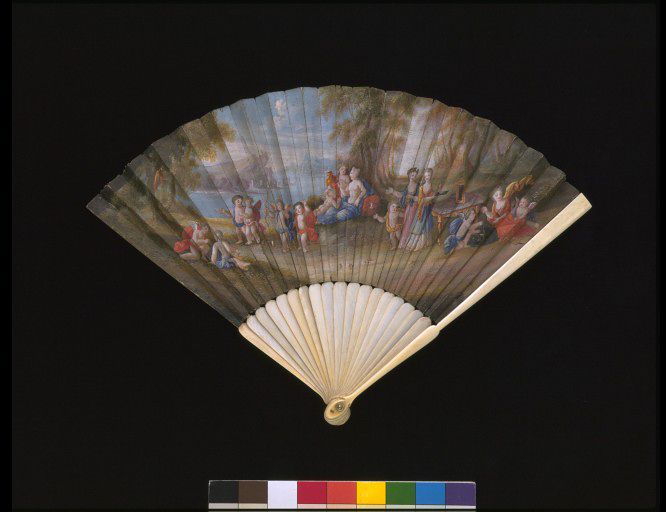
The toilette of Venus was a popular subject for fans in the late 17th and early 18th centuries. The scene shows the goddess getting dressed and surrounded by attendants. In this example the artist has set the scene, rather improbably, in a landscape beside a lake.
1690-1710
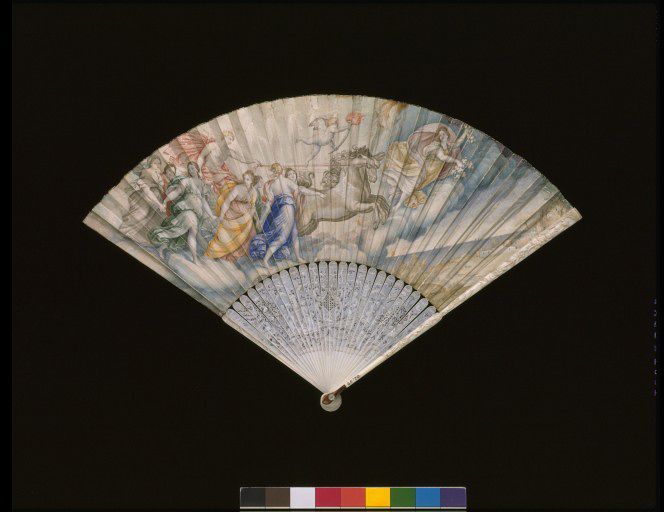
Classical mythology inspired many 18th-century fans. This one carries the image of ‘Aurora and the Hours with the Chariot of the Sun’. It is based on a painting by Guido Reni from the Casino Rospigliosi in Rome. The artist has faithfully translated the large scale of Reni's painting and delicately reproduced it on the fan leaf. The result demonstrates the Italian genius for fine fan painting using the pointillist (dots of colour) technique.

This fan is decorated with a classical scene, and may depict the meeting of Anthony and Cleopatra, though given the storm clouds and setting it could equally represent the meeting of another doomed couple from classical literature: Dido and Aeneas.

The Italian artist Leonardo Germo painted this fan. He based his image of Venus and Adonis on a painting by Francesco Albani in the Villa Borghese in Rome.
Germo, Leonardo
1680-1720
------------Изготовление вееров------------------------
Изготовление вееров состоит из нескольких операций, включающих две основных - подготовку остова и экрана веера. Этим занимались различные мастера-вееровщики - резчики и художники. Помимо них, существовали мастеровые, которые должны были соединить обе части в единый предмет.
Основные этапы изготовления веера во французских мастерских были запечатлены в гравюре и подробно описаны в Энциклопедии Дени Дидро, вышедшей в свет в 1765 году, в разделе «Eventailliste».
Первая иллюстрация изображает комнату в мастерской, в которой бумагу или пергамент смачивают специальным клеем, а затем склеивают, закрепляя с помощью особых полукруглых «пялец». Вторая иллюстрация представляет комнату, в которой у окна сидит женщина, раскрашивающая экран, третья - двух женщин, делающих складки на веере в соответствии с чертежом. Последняя иллюстрация представляет завершающий этап - монтировку заложенного складками экрана на остове, его окантовку и результат работы - готовый веер.
Об изготовлении вееров говорится и в «Школе искусств, художеств и рукоделий» некоего Жофре, изданной в 1820 году, в главе «Опахальщик». При этом отмечается, что «оправа для опахал работается токарями», в то время как «опахальщики их складывают и оправляют».
----------18 век---------------
===================================================
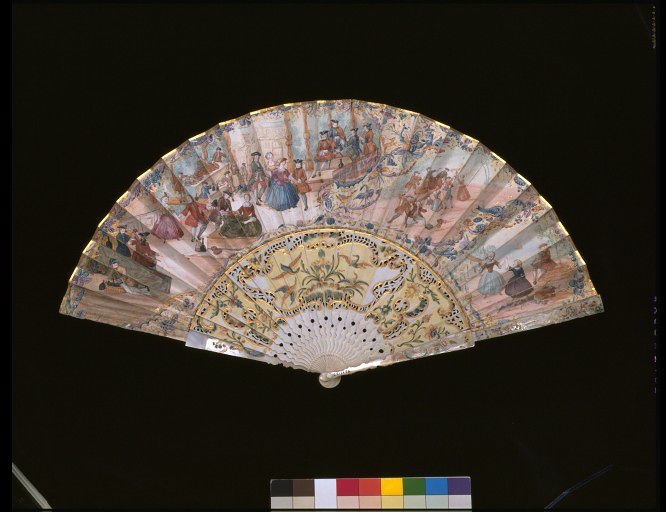
Marriage and its ceremonies were attractive subjects for fan painters. The marriage banquet is a popular scene on many 18th-century fans. This is a particularly charming version, with scenes of feasting and dancing.
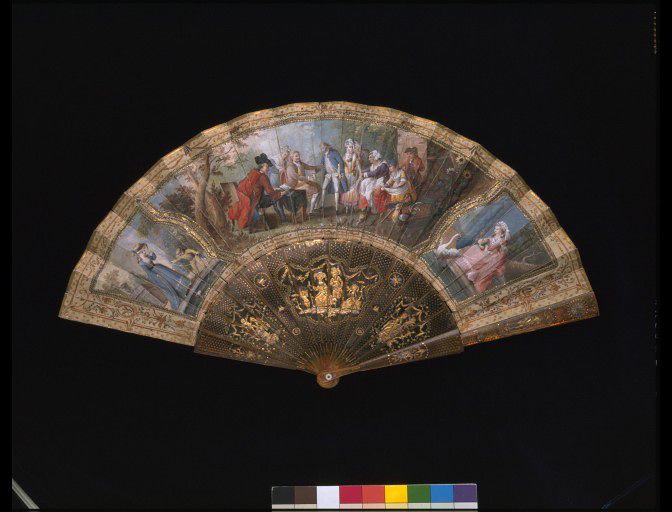
This fan has a silk leaf embroidered with sequins and highly decorated sticks. These are typical features of fans of the 1780s. It represents a marriage scene, possibly of a bride and groom of different social backgrounds. In England, this was a very popular subject in 18th-century literature.
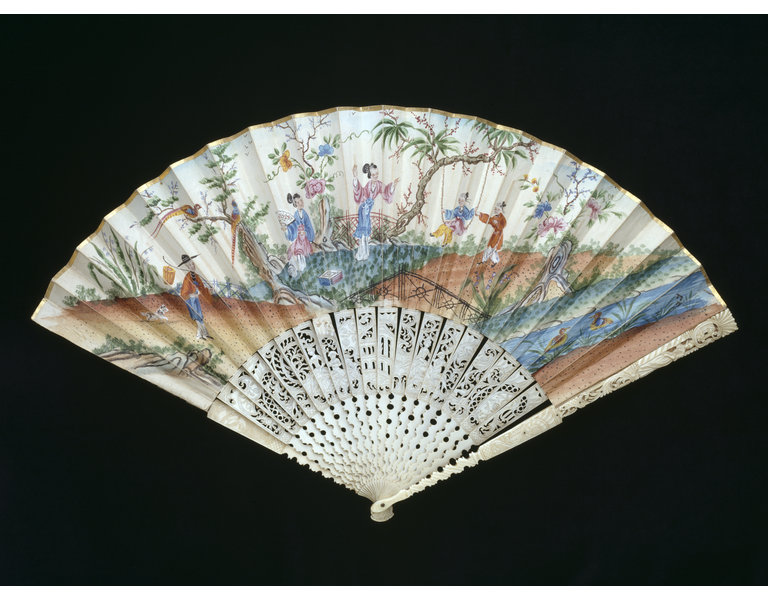
18th century (made)
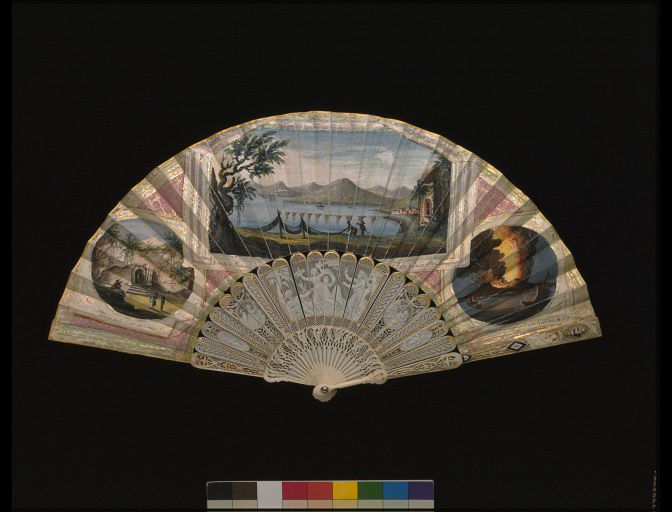
The ivory sticks are carved with scenes from Classical mythology. Apollo and Daphne are represented in the central cartouche, with putti in the smaller compartments.
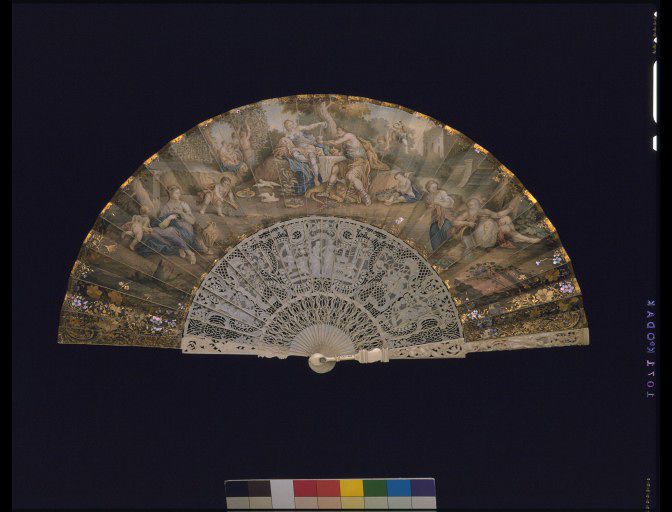
Bacchus and Ariadne
1730-1769
-----------------
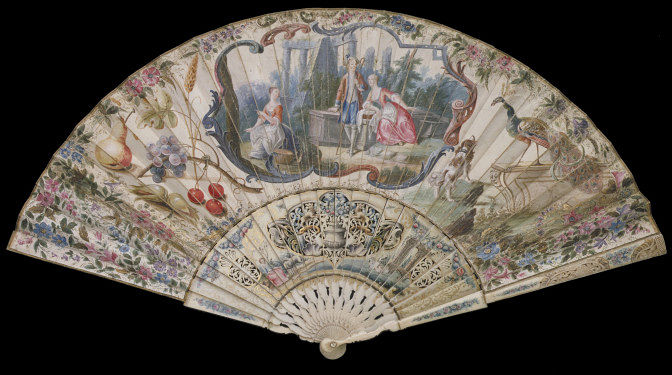
The central vignette of this fan represents a fashionable English garden of the mid 18th century. A stone bench, a ruined classical colonnade and a curious pyramid-like structure (possibly an icehouse) crowd the composition.
1760-1770

A view of the church of St Peter’s in Rome fills the leaf of this fan. The artist has fitted its curving colonnades to the shape of the fan leaf. Many Britons made ‘the Grand Tour’ of Europe during the period 1750 to 1790.
--------------------
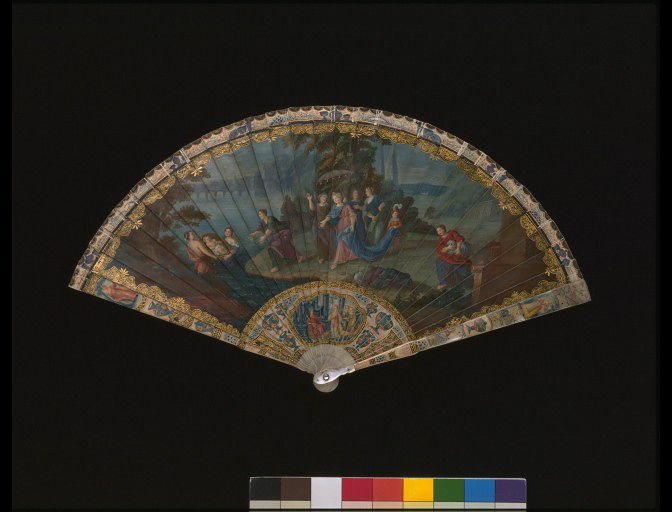
1700-1720 (made)

Черепаховый , позолота и живопись
1775-1800 (made)
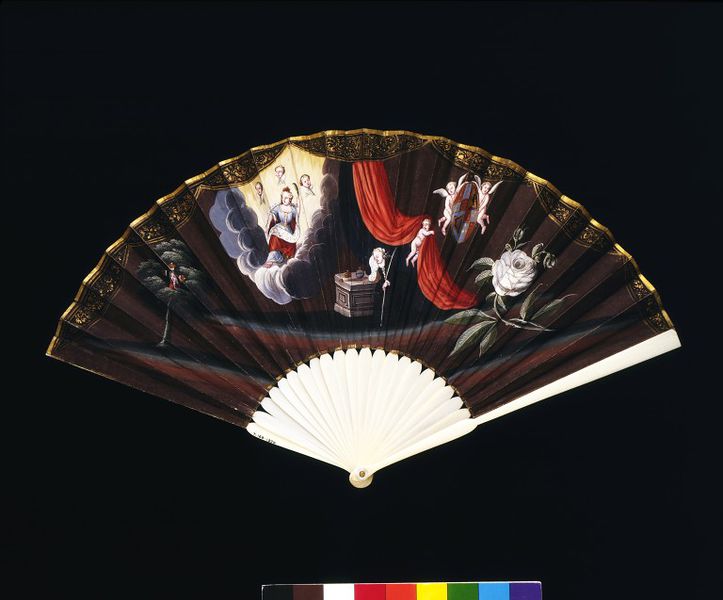
The folding fan originated in Japan and was introduced to Europe in the second half of the 16th century. The principles of construction of the Japanese version were adopted, but with European decoration.
1715-1730
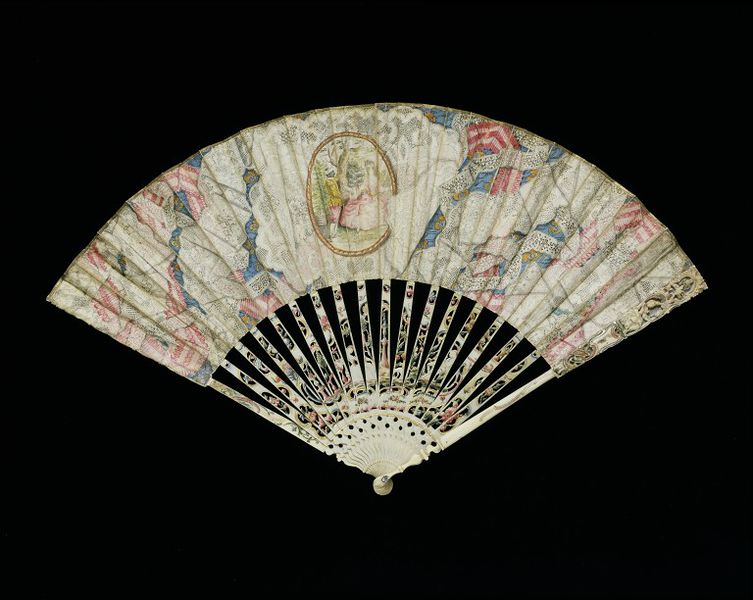
The image of the lady and the black servant on this fan is in a familiar tradition of representing black people in Britain as servants for white employers, or - in American and Caribbean contexts - as slaves. This image is unusual because it appears on a fan. The scene of a black man or boy serving a woman in a garden is reminiscent of Robert Hancock's popular design The Tea Part
1760
---------------------
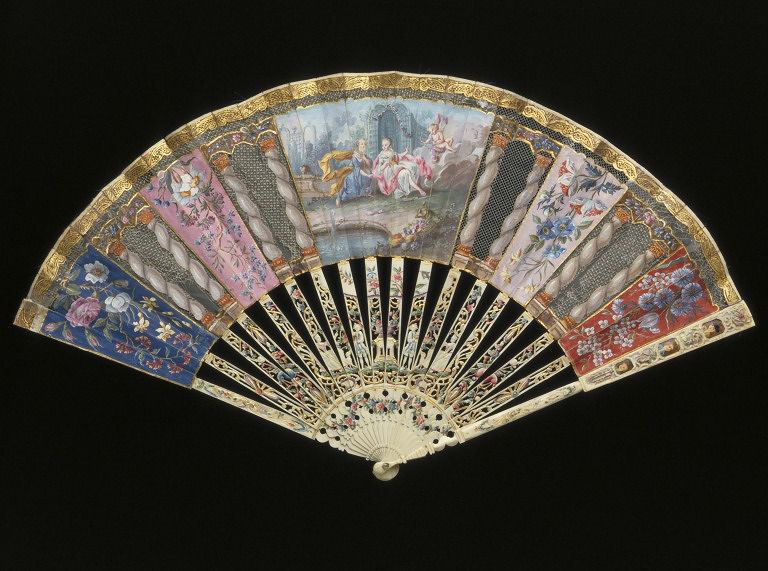
1760-1770 (made)
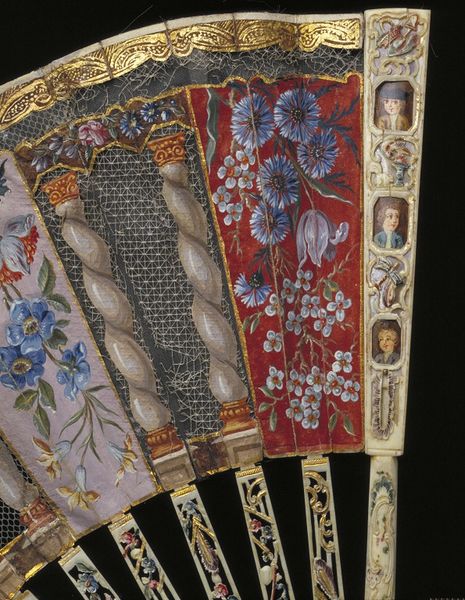
--------------------------
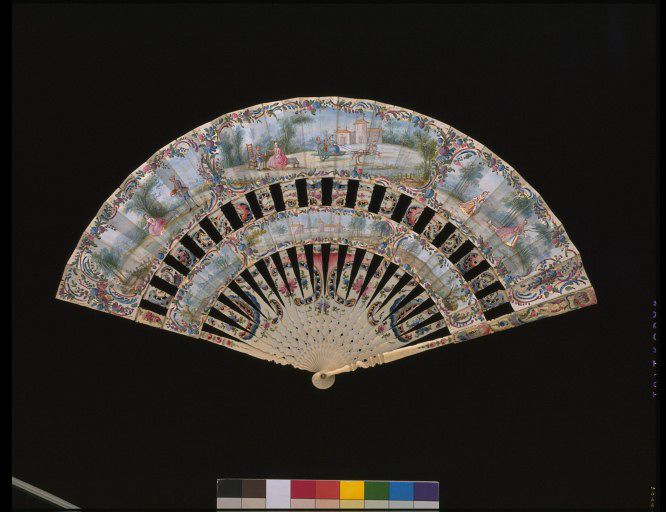
A very distinctive type of fan emerged in the mid-1750s. It was inspired by the cabriolet carriage, which Josiah Childs invented in 1755. This style featured two or three separate concentric leaves on the sticks, following the shape of the cabriolet carriage wheel.
------------------------
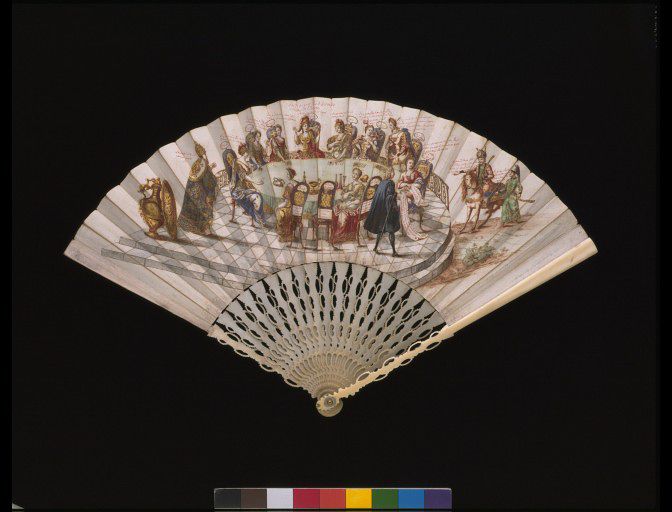
Many printed fans commemorated the heroes and battles of European wars waged between 1700 and 1740. This fan is called ‘Jeu de Piquet des différentes nations de l’Europe’ ('A New Game of Piquet now in play among the different nations of Europe').
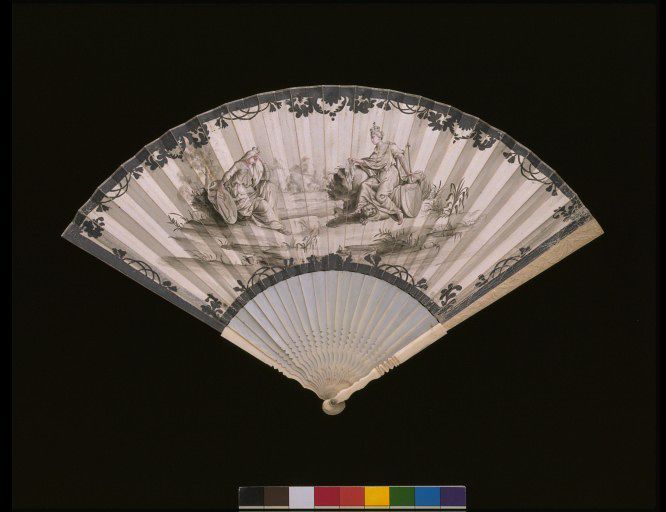
Fans often commemorated the death of someone famous. This fan marks the death of Frederick, Prince of Wales (son of George II) in 1751. The image of Britannia with her shield, spear and lion is typical of this type of fan. On the left is a weeping allegorical figure carrying a shield with the Hanoverian horse emblem, representing the Royal Family
--------------
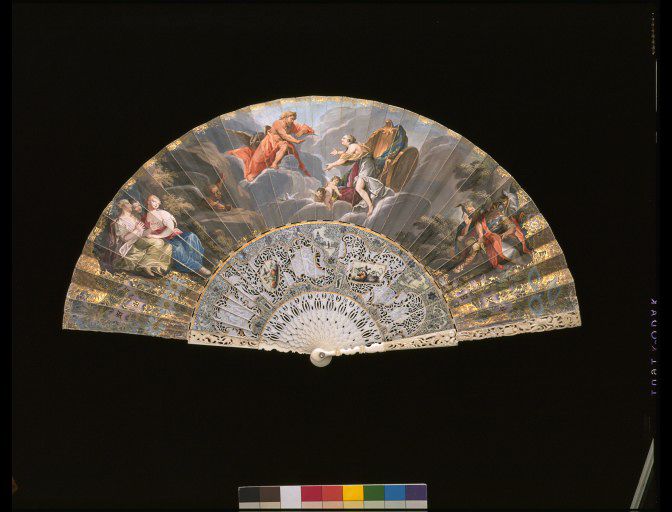
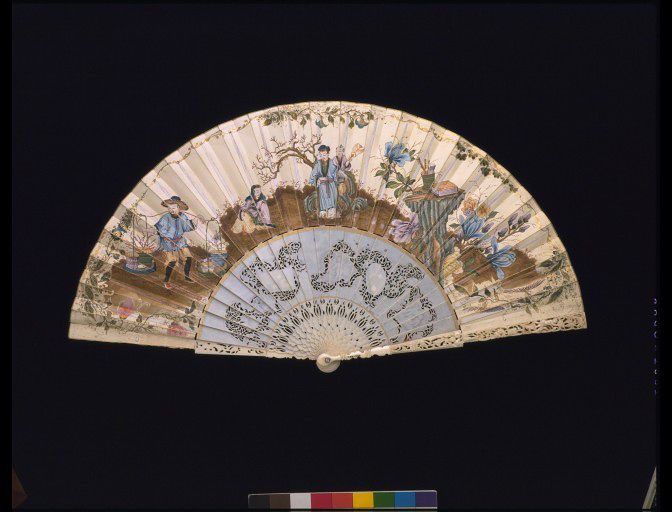
Classical mythology inspired many 18th-century fans. The standard of painting on the leaf was often very high, as you can see in this example of 'Venus interceding with Jupiter’. The artist has painted the reverse of the leaf with another popular 18th-century fan subject - a Chinoiserie scene.
1730-1769
--------------------
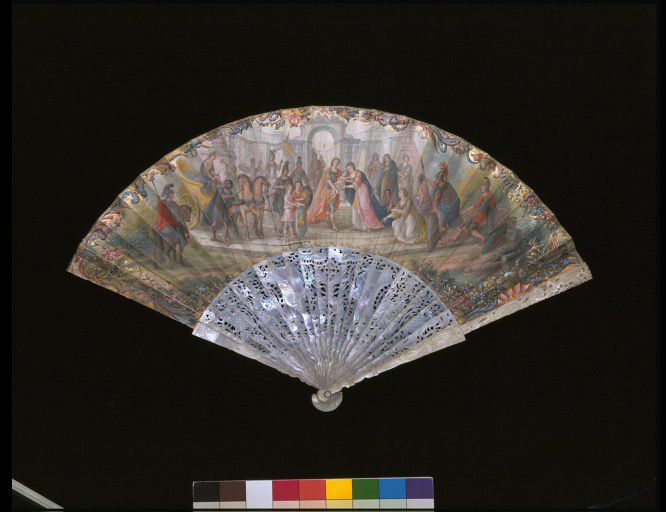
This finely painted fan shows ‘Hector’s Farewell to Andromache’. This is an episode in 'The Iliad', an epic Greek poem by Homer about the Trojan War. Andromache’s pleas fail to prevent her husband Hector from joining battle with the Greeks and he is later killed by Achilles. The mother-of-pearl sticks have superb carving and piercing and add richness and lustre.
1730-1750 (made)
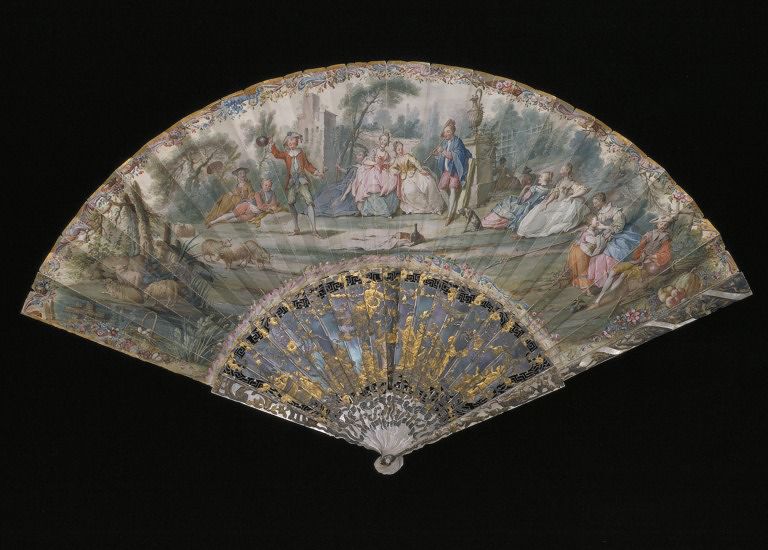
Pastoral scenes were popular subjects for fan leaves in the 18th century. They depicted highly romanticised views of landscapes and rural pursuits. Antoine Watteau was a well-known French painter of pastoral scenes. His works served as models and inspiration for many fan painters throughout the century. This fan clearly shows Watteau's influence

Some mid 18th-century fans are miniature versions of paintings by well-known landscape artists. The work of Joseph Vernet inspired this particular example. He was famous for his harbour scenes, and his paintings characteristically show groups of fishermen and fishing boats. The painter of the fan leaf has faithfully reproduced Vernet’s style and composition
Unknown
1750-1760
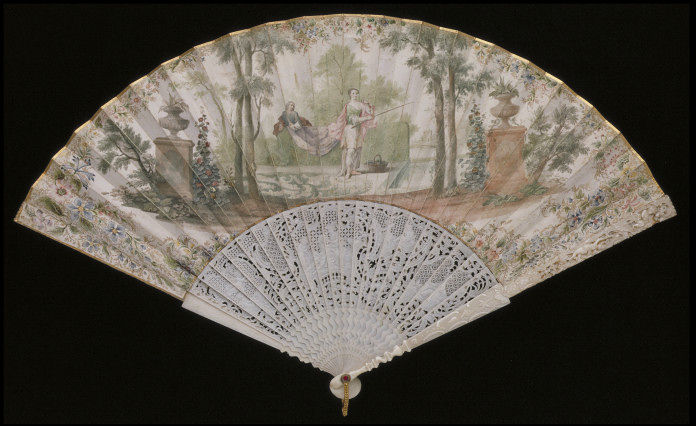
The scene includes vibrant red hollyhocks beside two classical urns and a canopy of leafy branches. The accuracy of the flower painting is a clue to where the fan was made. English fan artists and designers were renowned for their precise interpretations of flowers and foliage.
Unknown
1740-1750

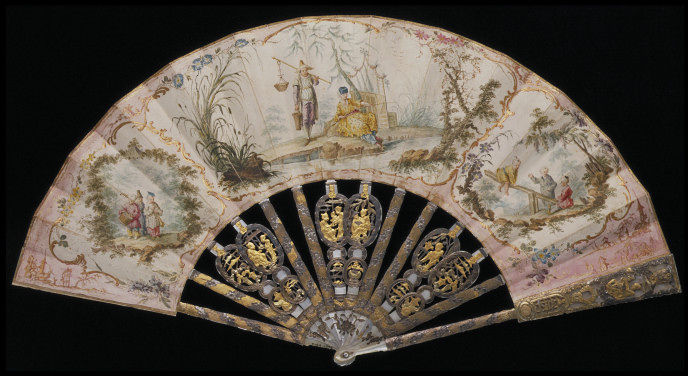
This is a particularly fine example of a Chinoiserie fan made in France. Three vignettes make up the design. They show Chinese fishermen, Chinese children playing on a see-saw, and Chinese children making music. The fan maker based these images on designs by Jean-Baptiste Pillement. His designs were published around 1758. In 1760 Robert Sayer incorporated them into a design source book, The Ladies Amusement.
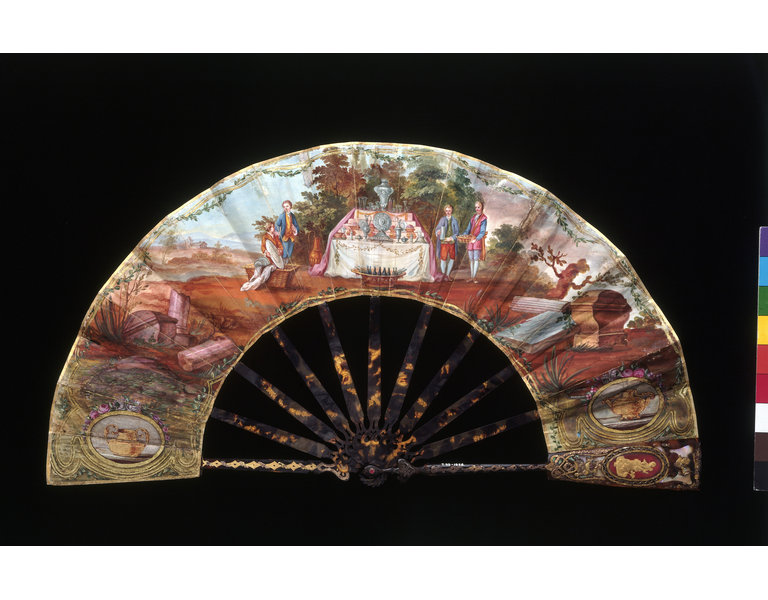
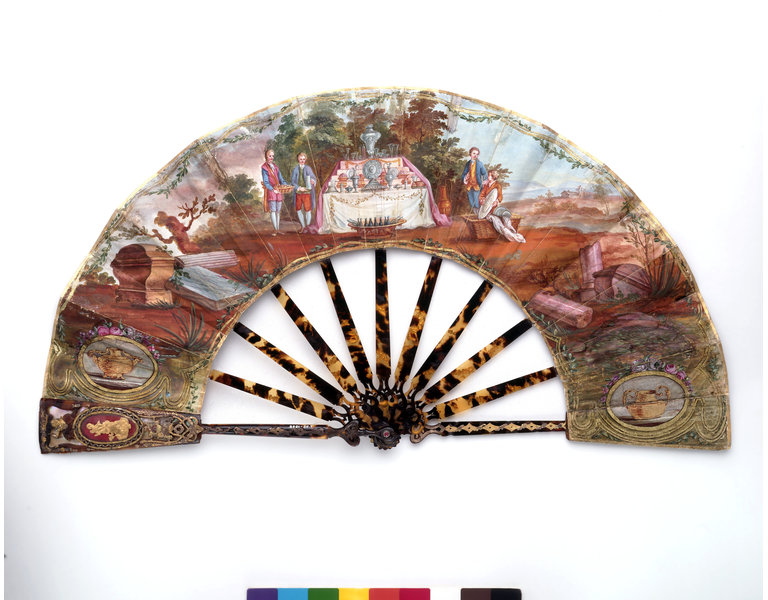
Scenes commemorating the marriage banquet were popular subjects for 18th-century fans. In this example, the fan painter has combined it with the taste for classicism and portrays the Altar of Hymen (god of marriage). As the bride and groom approach, clouds billow around the altar, a rainbow springs from the earth, and angels hold aloft portraits of the couple
1750-1760 (made)
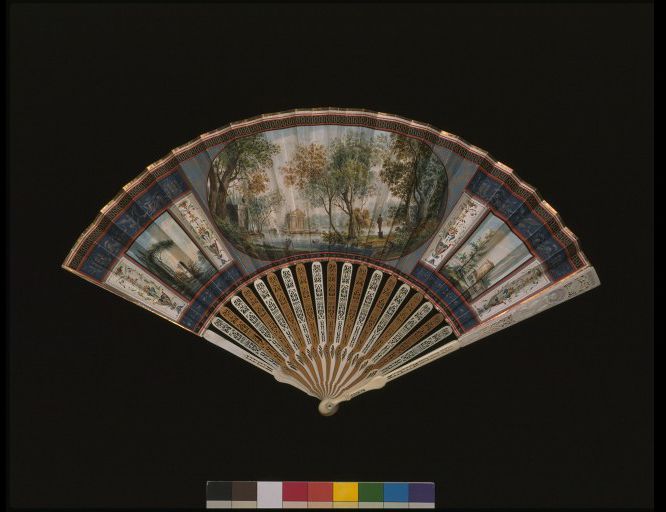
This fan leaf shows a view of the English garden at the Villa Borghese in Rome. An Englishman, Jacob More, designed the garden, which was completed in 1787. It incorporates a number of ‘classical ruins’, invented by Antonio Asprucci. You can see one of them - 'the Temple of Aesculapius' - in the central vignette.

George III (reigned 1760-1820) recognised the importance of creating a positive image for the Royal Family. He actively encouraged painters to record his public appearances with the queen and their children. This fan is based on a painting by Johann Heinrich Ramberg and depicts the king and Royal Family attending the Royal Academy Exhibition in 1788. It is a high-quality printed fan. The maker was Antonio Poggi, who worked in London from 1776 to 1799.
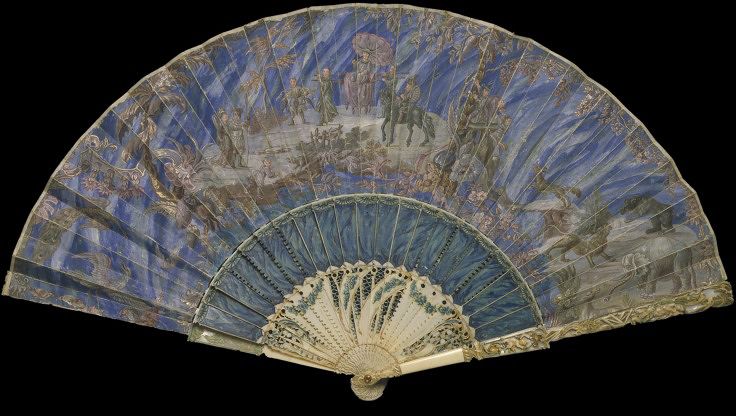
This painted fan shows the element of fantasy in Chinoiserie styles. An island floats in mid-air, while a person of rank in oriental costume is carried on a litter and attended by a warrior on horseback.
Unknown
1730-1750
------------------
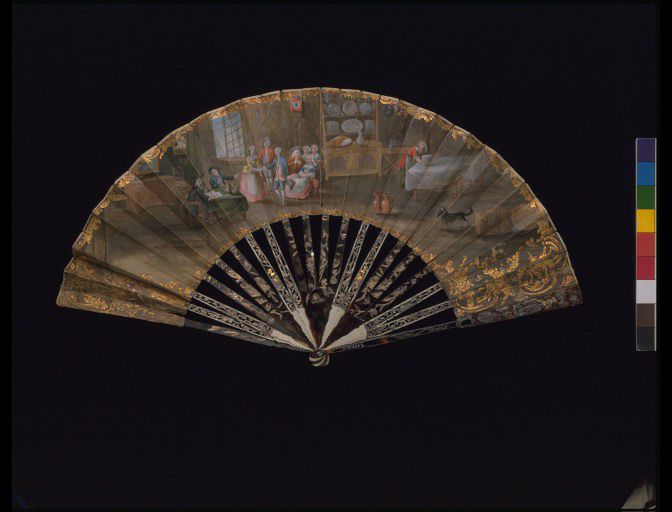
This fan leaf depicts the signing of a marriage contract. The couple hold hands rather self-consciously in front of two lawyers, who are seated at a table with the marriage documents in front of them.
1760-1770
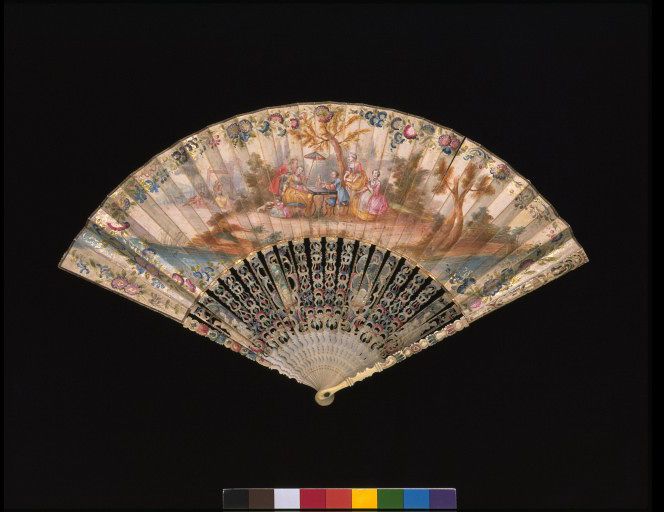
Unknown
1750
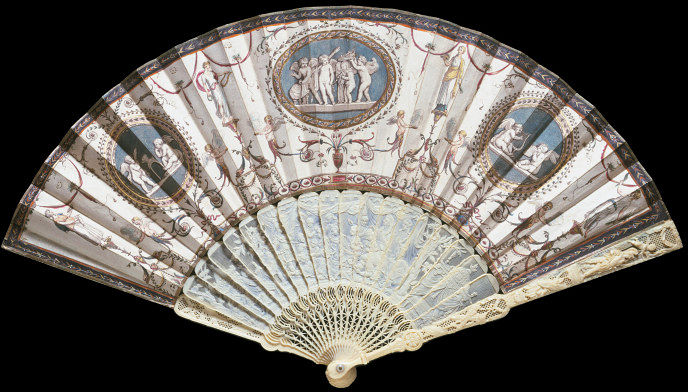
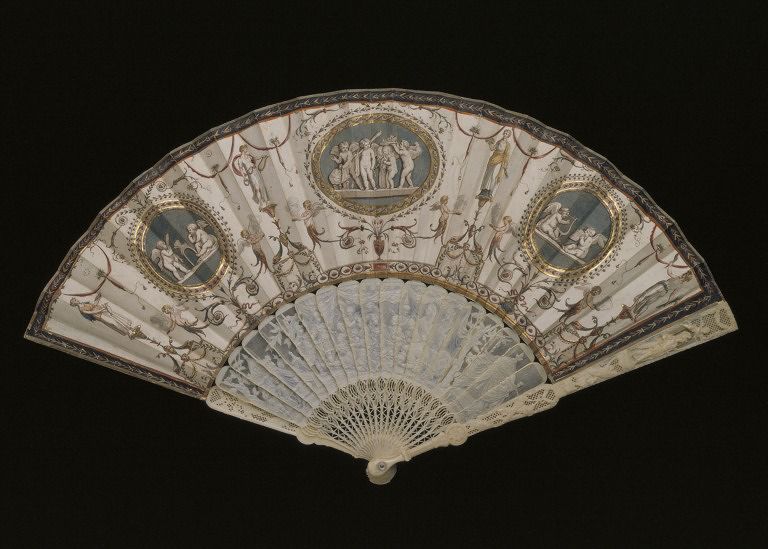
By the late 18th century, some Italian fan makers were working in London. Here they capitalised on the English taste for the Neo-classical style. This fan uses an etching by Francesco Bartolozzi, who worked in London from 1764 to 1802. The vignettes imitate relief sculpture. They are taken from a book Designs and Ornaments, published from 1777 to 1782.
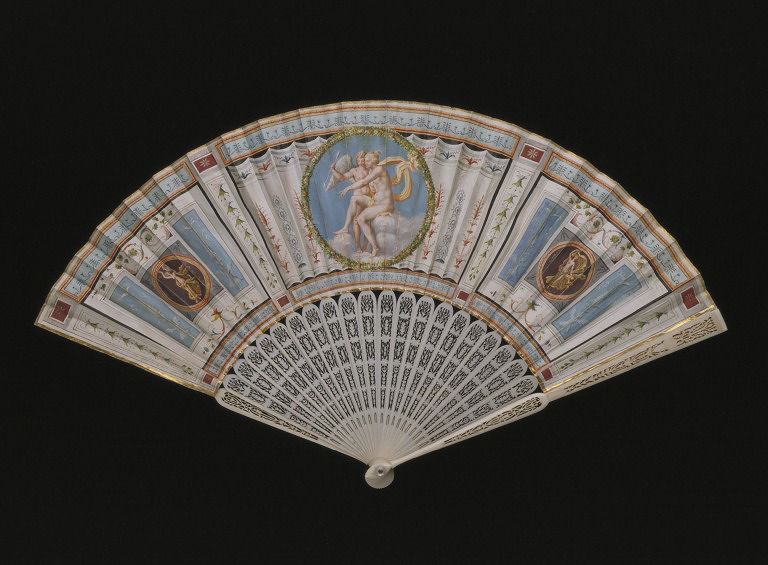
Some of the finest surviving tourist fans have subjects based paintings rather than architecture. The central vignette of this Italian fan comes from a fresco by Raphael at the Villa Farnese on the Palatine Hill. It shows Venus ordering Cupid to punish Psyche for her vanity
1790-1800 (made)
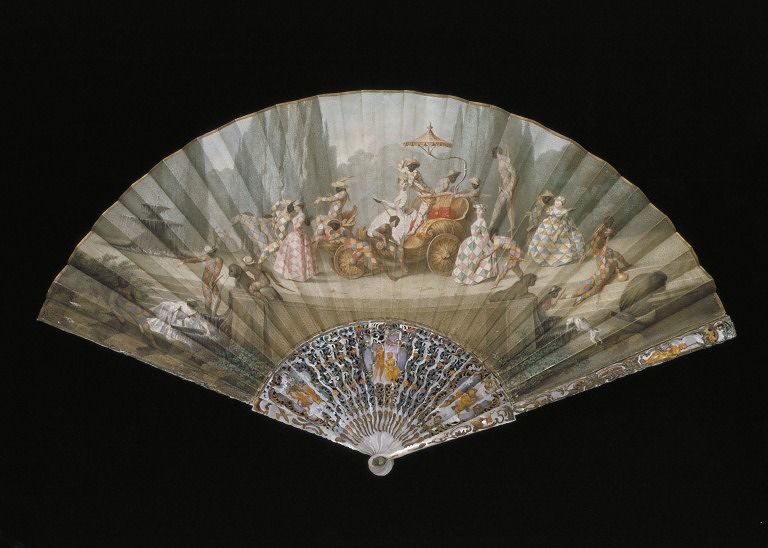
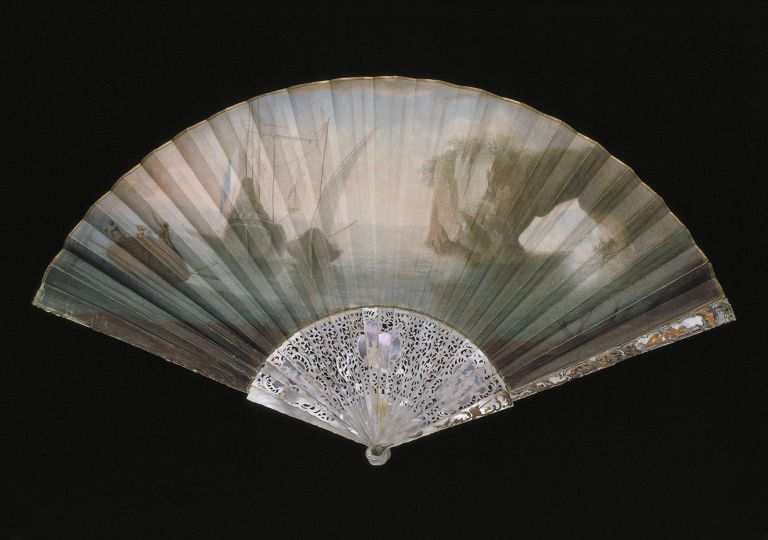
Visitors from all over Europe flocked to the Carnival in Venice in the 18th century. This fan illustrates the ‘Triumph of Harlequin’. It shows the costumed figures associated with the popular Italian theatre troupe the Commedia dell’Arte and their distinctive costumes.
1750
-------------
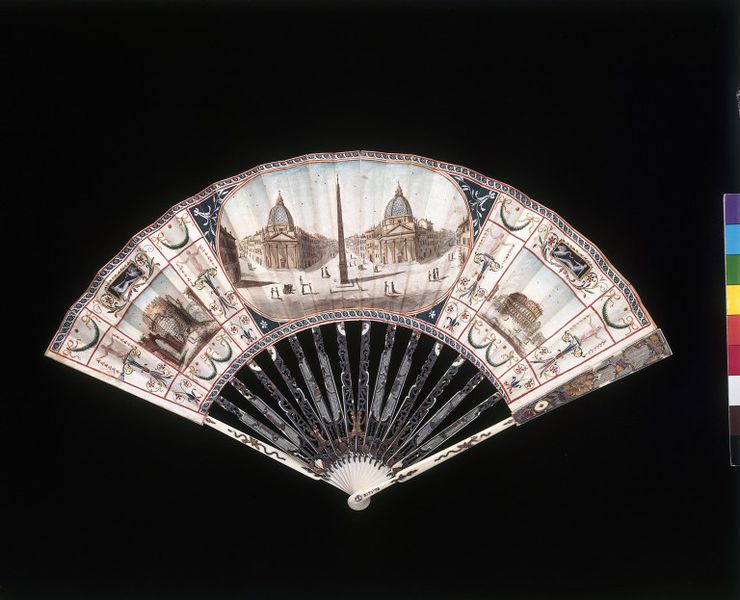
Rome was one of the most popular cities on the ‘Grand Tour’ of Europe. From about 1750 to 1790 many Britons visited the city. They bought fans made for the tourist industry that commemorated well-known ‘sights’.
----------------------------
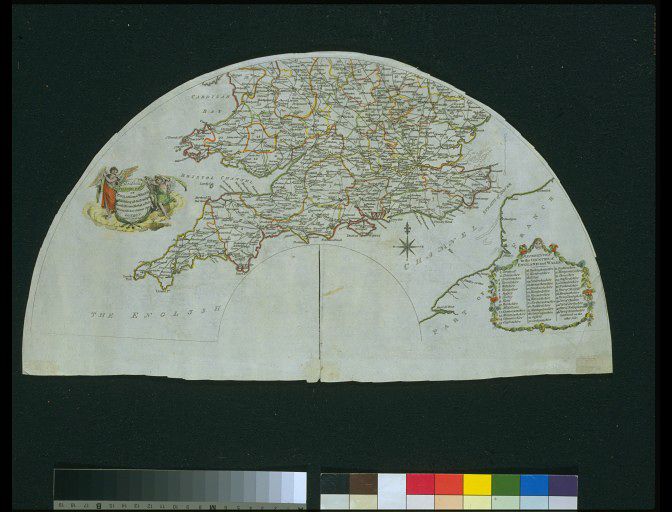
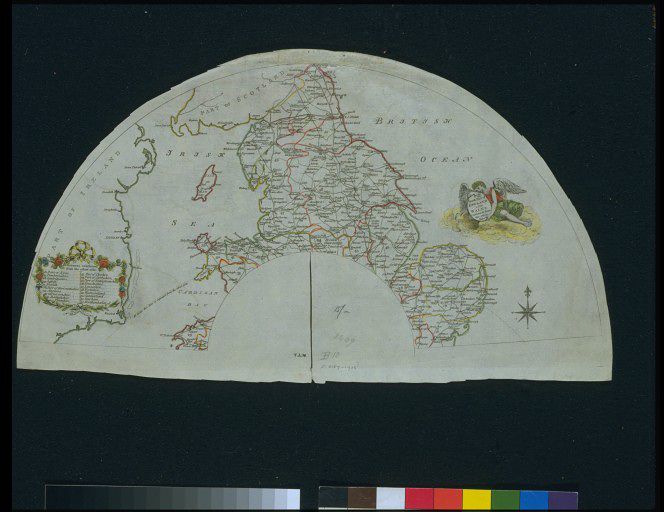
This unfinished fan mount has a wrap-around map of England and Wales and includes a list of counties. England led the way in the 18th century in the sale and export of printed souvenir fans. They reproduced subjects such as commemorative or topical events, games or useful facts.
===============================================
------------Материалы для вееров--------------------------
Как правило, вееровщики использовали три основных материала для изготовления остова - слоновую кость, перламутр и черепаху. Для особо драгоценных вееров остов делали из золота, а лицевые пластины украшали драгоценными или полудрагоценными камнями. Иногда подобные золотые с драгоценными камнями накладки были и на перламутровых или костяных веерах.
Слоновая кость для вееров обычно поставлялась из Цейлона. Она называлась Индейской слоновой костью и отличалась необыкновенной белизной и тонкими внутренними слоями. К тому же при распиливании клыка по его длине внутри его мастера находили различные оттенки, переходящие в из цвета чая с молоком в розоватый. Кроме цейлонской, получали кость с мыса Доброй Надежды, которая имела несколько желтоватый оттенок. Третьим сортом являлась гвинейская слоновая кость, называвшаяся зеленой, поскольку имела подобный оттенок и со временем не желтела. Кроме того, резчики, особенно в России, издавна использовали моржовую кость, которая шла в основном на более дешевые виды вееров. Использовалась (и используется до сих пор в качестве реставрационного материала) «ископаемая сибирская» или мамонтовая кость. Последняя на сегодняшний день является
единственным материалом, не запрещенным к использованию в декоративно-прикладном искусстве, и потому совершенно бесценна для реставрационных работ.
-------------19 век--------------------
========================================================
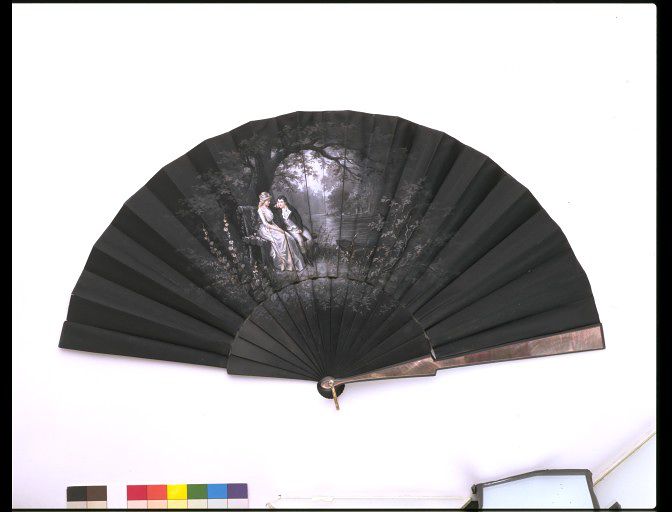
1880-1900

Fan
Ronot-Tutin
1890-1900
------------------
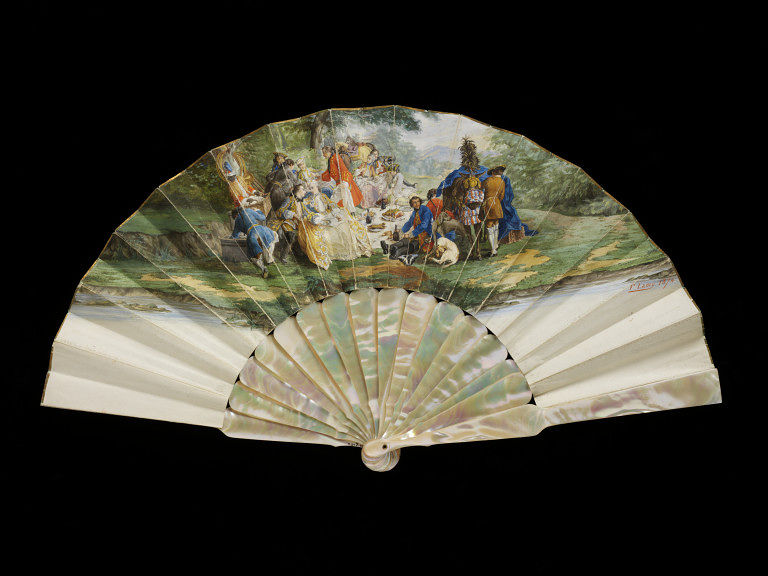
Historical subjects in the Rococo style remained popular as fan decoration from 1870 to 1890. Often fan painters copied the work of well-known 18th-century pastoral artists directly on to fan leaves. In this example, the fan painter F. Lamy has copied The Picnic Party by François de Troy.
----------------------------
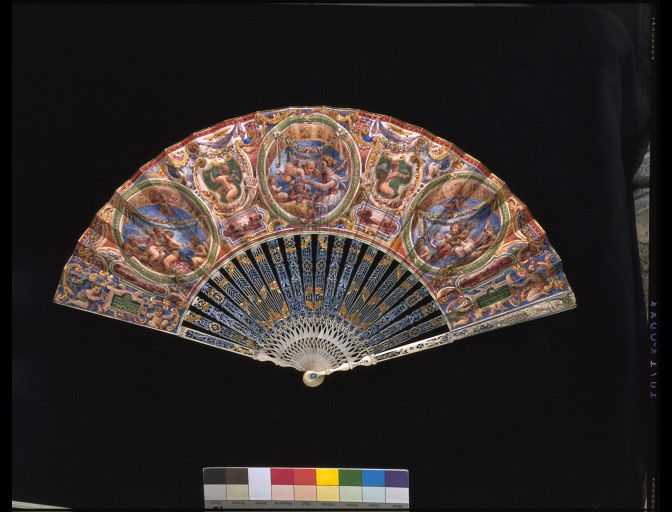
Sir Matthew Digby Wyatt was an eminent artist and art historian. He acted as an Art Referee for the South Kensington Museum (later the V&A), recommending acquisitions. He and his wife were keen collectors of fans. They amassed some 400 from Europe and East Asia, which they donated to the V&A in 1876. Sir Matthew designed and painted this fan as a gift to his wife in 1869. The images on the fan leaf are an allegory on the ‘Triumph of Love’. Part of the inscription reads ‘For Love is Heaven and Heaven is Love’. It is signed ‘M Digby Wyatt to Mary Wyatt’.
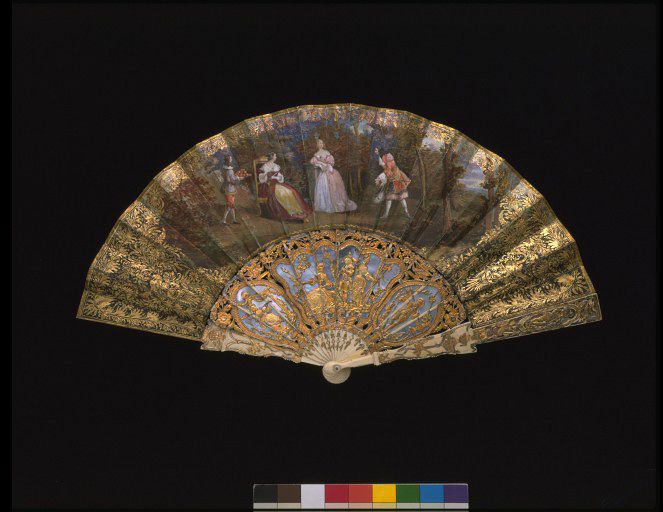
During the 19th century people were fascinated by the events and artistic styles of the past. This fan is a particularly fine example of the many fans decorated with romantic versions of previous eras. The scene is probably meant to resemble the time of Louis XIV, as figures are wearing the fashions of his reign (1643-1715). The painting and decoration of the fan, however, imitate the Rococo style of the 18th century.

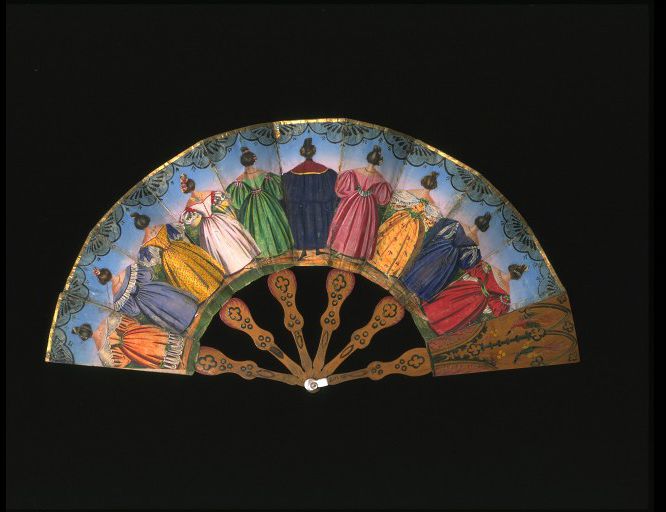
In the 19th century the decorative themes for fans became more light-hearted. They often played with the idea of the right side and reverse of the fan leaf, as you can see in this example. A row of women in fashionable dress of the 1830s stand on either side of a man wearing a cloak. A back view of the figures appears on the reverse. The sticks are shaped like a guitar. The fan was probably made for the Spanish market.
Unknown
1830-1840
-------------------------
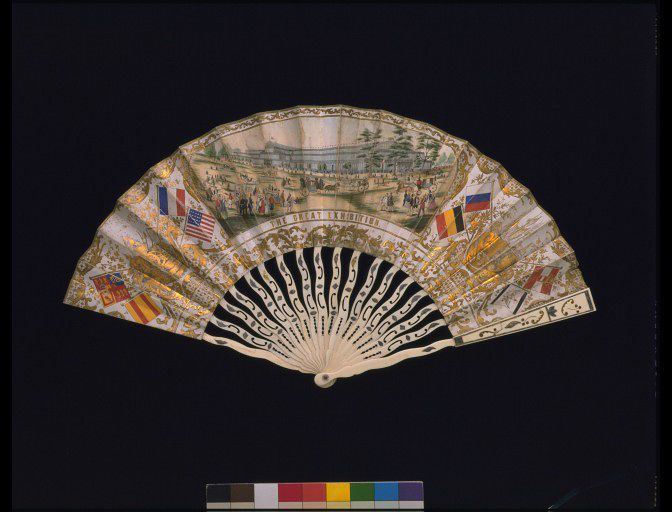
This fan commemorates the Great Exhibition of the Works of Industry of All Nations of 1851. Prince Albert organised the exhibition to celebrate the products and manufactures of the world. The site was Joseph Paxton’s ‘Crystal Palace’ in Hyde Park in London
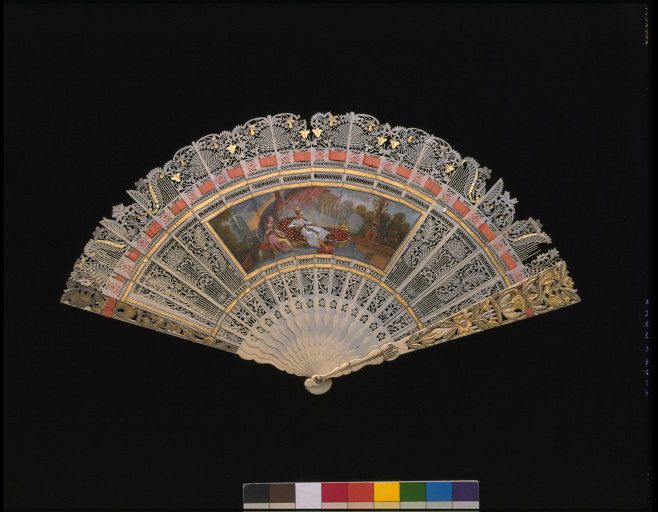
This very fine ivory brisé fan is so delicately carved and pierced that it looks like filigree. It formed part of a collection of fans which originally belonged to the daughter of General Don Juan Manuel de Rosas. He ruled Argentina from 1835 to 1852. On the reverse of the fan is an inscription ‘Viva La Federacion 24 Mayo’. It probably refers to the federalist government that General de Rosas imposed between 1829 and 1832.
---------------------
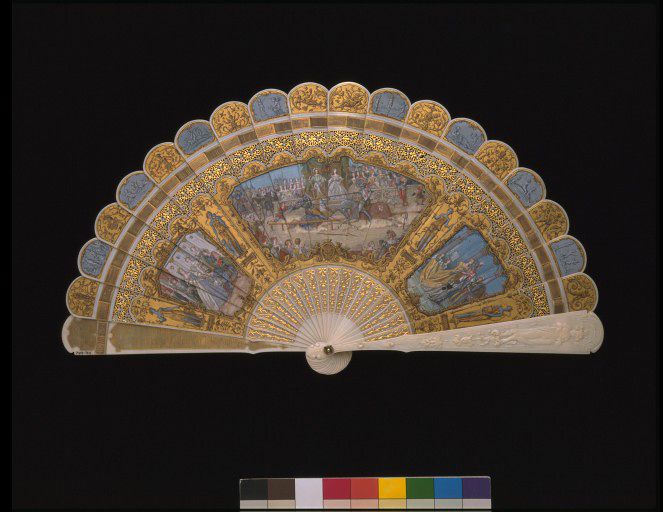
This fan is plain on one side, with elaborate scenes of a medieval jousting tournament on the other. The painter was Edouard Jean-Baptiste Moreau, who often worked for fan makers. He was famous for his finely painted miniaturist compositions, which generally represented romanticised scenes from the medieval or Renaissance period.
Moreau, Edouard Jean...
1867
---------------------------------
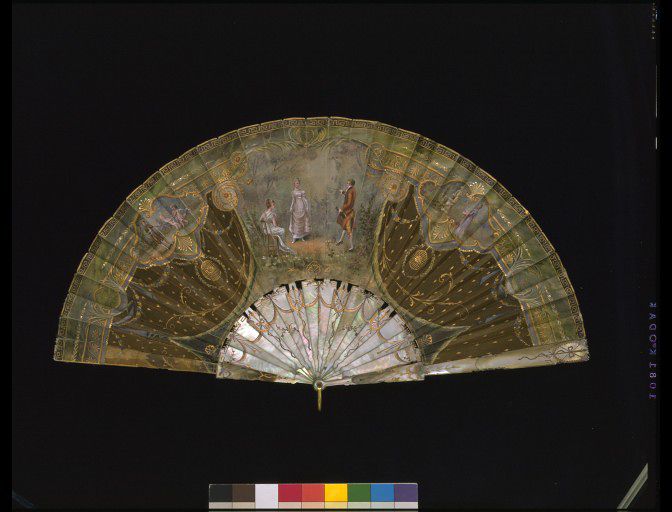
From 1890 to 1910 fans made in Paris were very sumptuous. Their style and subject-matter, however, remained fairly traditional. In the early 19th century fan painters copied 18th-century subjects. Here the fan painter has taken a scene from the period 1800 to 1820. However, the romantic overtones remain and it looks like a moment captured from a Jane Austen novel. The decorative design of the fan remains a pastiche of the Rococo style.
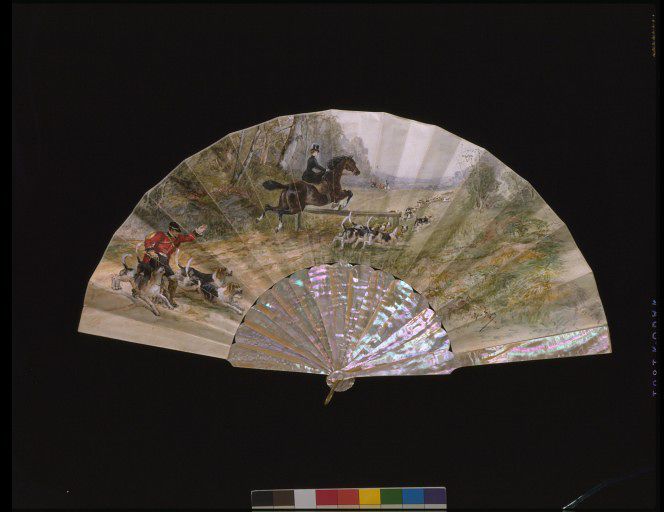
Marie, Duchess of Orléans was an accomplished fan painter. Her speciality was hunting scenes, as shown on this fan. Here she has fitted the huntsman, the dogs and the rider into the fan leaf. A light, impressionistic technique suggests the woodland setting.
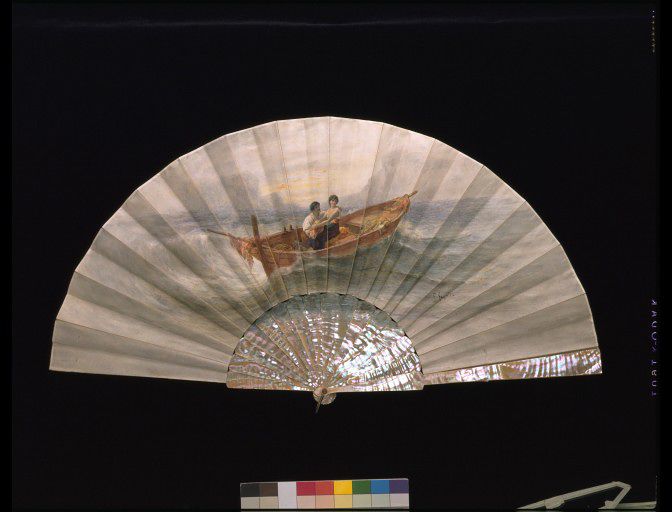
Francis Houghton was a prolific and talented English fan painter. We know very little about him, but a number of his fans survive. The dramatic scene on this fan leaf is typical of his work. The man leaning over the side of the boat is presumably saving the girl, who is stranded out at sea in a rowing boat. The fan is large - over 61 cm wide. Houghton has painted the sea over the sticks to give the impression of the water stretching out to infinity. This was a common device on English fans of the 1890s.
-------------------------------
«Черепаховыми» называются веера, выполненные из пластин, покрывающих верхний череп и грудь морской черепахи, некогда ловимой в водах около остовов Борнео, Бали, а также близ Гвинеи и Мексики. К самым лучшим сортам относилась черная черепаха, испещренная бледно-желтыми пятнами, с винным оттенком на просвет а также крапчатая с коричневым фоном и пятнами красноватого оттенка. Пластины черепахи (тринадцать больших и двадцать шесть маленьких) имеют неравные изгибы и толщину. Их нагревали до степени теста, а затем придавали различные формы, для вееров - прессовали в виде более-менее плоских пластин. В XIX веке использовали также поддельную черепаху. Для этого брали роговую пластину, на которой с помощью кисти изображали пятна, имитирующие настоящий черепаховый узор. Кисть пропитывали веществом, составленным из извести, поташа и сурика, и таким образом узоры проникали глубоко в рог. После полировки рог представлял почти полную аналогию с настоящей черепахой. Отличие можно определить, взвесив вещь - черепаховые веера относительно легче.
-----------------------------

1900 (made)
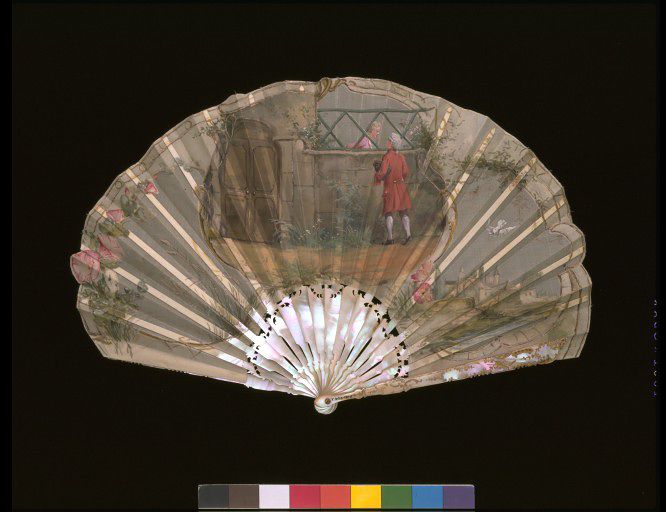
The famous Parisian firm of Duvelleroy probably made this fan. Jean-Pierre Duvelleroy established the fan-making business in 1827, and by 1887 it had two shops in Paris and one in London. The decoration on the fan leaf brings together two styles. The fan painter has included elements of the popular Rococo style of the 19th century and the romantic style of the 18th century.

The Gothic Revival was an art movement inspired by medieval art and architecture. It became popular in the 1830s and 1840s. On fans such as this one, the style took the form of delicately pointed tops to the sticks.
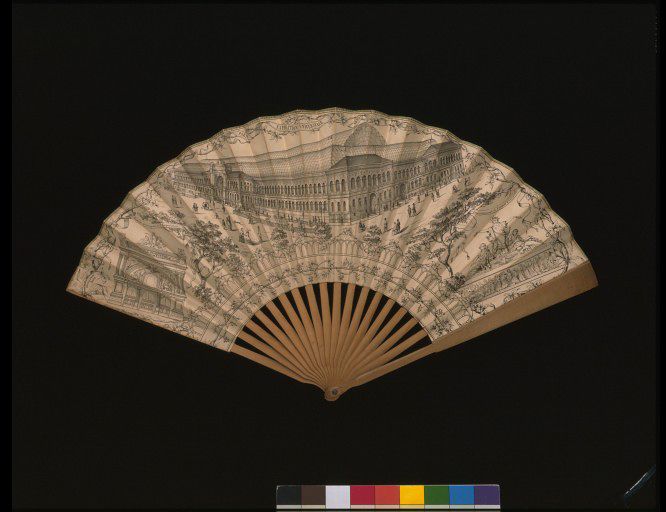
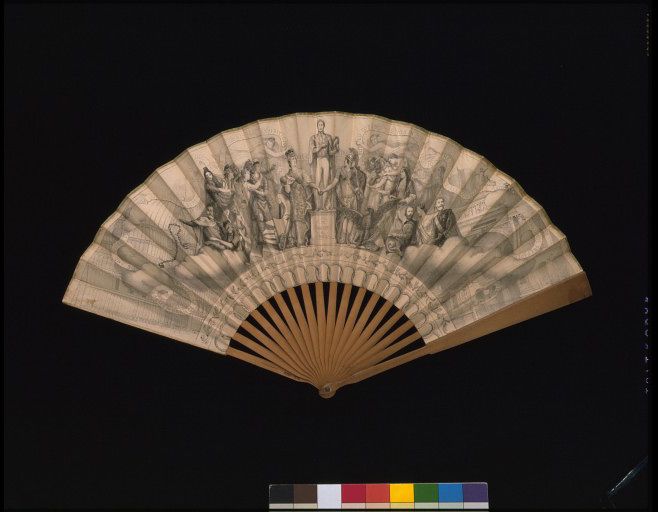
This French fan commemorates the Paris Exhibition of 1862. The French exhibition was held to rival the Great Exhibition of 1851 in London. The reverse of the leaf, however, pays tribute to Prince Albert, who died in 1861
----------------
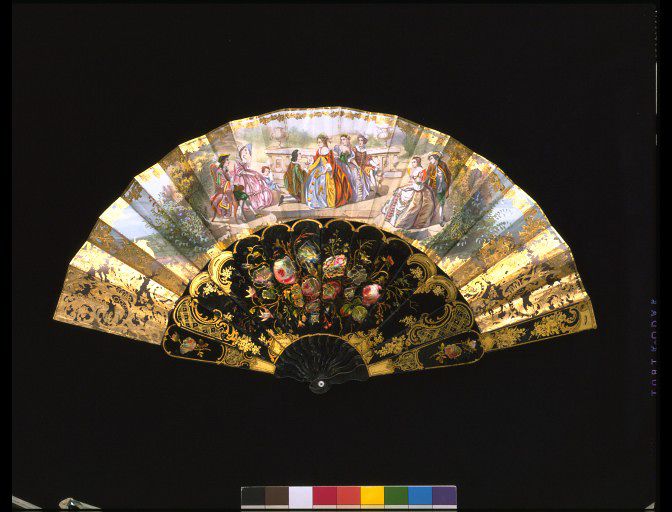
Printed lithographic fans became the most popular type from about 1840 to 1870. They had watercolour washes as decoration and elaborate sticks of bone, ivory, mother-of-pearl, lacquered wood or papier maché.
1840-1860 (made)
Другим материалом является перламутр, то есть раковина от так называемых жемчужных устриц. Для вееров использовался белый и серебристый перламутр, привозимый из Мадагаскара, а также черный перламутр, привозимый из Сиднея. Последний имеет цвет с переливами из лилово-синего в черный, с красным, голубым и зеленым отливом. Использовали и так называемый восточный перламутр, добываемый в Японии. Однако самым популярным сортом для вееров был перламутр под названием «золотые рыбки» - с яркими розовато-сиреневыми переливами. Он чаще всего применялся в качестве фона для резьбы нижних пластин остова. В конце XIX века перламутр часто подкрашивали анилиновыми красителями для придания ему ярко-золотистого или темно-синего цвета.
Помимо вышеописанных материалов, веера изготавливали из рога, картона, различных пород дерева, в основном вишни, яблони и карельской березы. Из привозных пород использовали душистый сандал, кипарис и черное дерево. В конце XIX - начале XX веков появились дешевые веера из целлулоида, однако они, как правило, не представляют какой-либо художественной ценности. Кроме того, XX век привнес новые материалы, использующиеся до сих пор для изготовления вееров, в первую очередь различные виды пластмасс.
В современных небольших веерных мастерских Европы делают веера из самых разных материалов - как правило, на заказ.
-------------------------20 век----------------
===================================================

This type of novelty fan was popular during the early years of the 20th century. It appears slightly unusual because its leaves are cut in the shape of a pigeon in flight. Many fans of the period used the shapes of cats’ heads, birds or butterflies to form the fan leaf.
ca. 1910 (made)
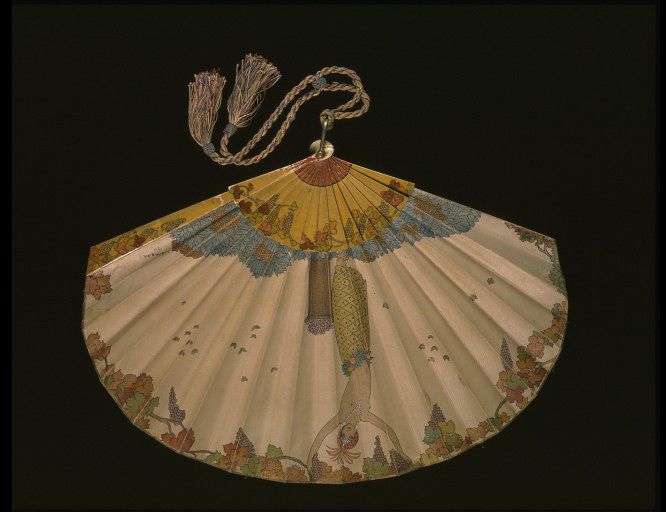
Georges Barbier was a leading fashion illustrator in Paris in the early 20th century. He collaborated with the most avant garde fashion designers of the day, such as Paul Poiret and Madame Paquin. The elaborate oriental costumes of the Ballets Russes, who performed in Paris, strongly influenced fashion in the 1910s.
1911
Старинные веера.История и фотографии.Antique fans.Part 1-Here
Все посты про веера, (рекламные и каминные)-All posts abot fans-Here
Очень интересная экскурсия в музей вееров в Париже моей любимой elle_812
http://elle-812.livejournal.com/220927.html
------------------------------------------------
http://collections.vam.ac.uk/search/?offset=0&limit=15&narrow=&q=fan&commit=Search&quality=1&objectnamesearch=&placesearch=&after=&after-adbc=AD&before=&before-adbc=AD&namesearch=&materialsearch=&mnsearch=&locationsearch=
http://digitalgallery.nypl.org/nypldigital/index.cfm
http://bankrabot.com/work/work_63886.html



В этом посте, в основном- очень редкие расписанные веера с разнообразными сюжетами из музея Виктории и Альберта.
Сюжеты очень интересные- от мифологических до бытовых, (те, кому трудно читать по английски, могут загрузить линк на пост в гугл-переводчик:http://translate.google.ru/#)и читать сразу все интересные описания.
====================Веер в истории========================

Woman holding a fan, Spain, 14th century

Veiled woman holding fan, Turin, Italy, 16th century.
Первые складные веера были завезены в Европу португальскими купцами из Японии и Китая. Как ни странно, свое триумфальное шествие по Европе модная восточная диковинка начала из Ватикана, с которым португальцы имели торговое соглашение. Сами итальянцы уже в XVI веке достигли больших успехов в изготовлении вееров. Даже большие живописцы не чуждались этого, казалось бы второстепенного, жанра. Братья Караччи, по некоторым сведениям, расписывали веера на вилле Монсиньори близ Болоньи, а Доменикино (1581-1641) создавал рисунки для экранов.
Во Франции складной веер распространился благодаря королеве Екатерине Медичи (1519 - 1589) - племяннице папы Льва X. Именно она привезла во Францию различные предметы роскоши - духи, перчатки, носовые платки и веера, среди которых были и складные. Их можно видеть на картинах, изображающих «Бал по случаю свадьбы Герцога Жуаёза» (1581) и «Бал при дворе Валуа» (1582).
В конце XVI века из Франции складные веера проникли в Англию. Королева Елизавета I на своих поздних портретах часто изображалась со складным веером в руках. Складные веера среди прочих упоминаются в описи гардероба, сделанной после ее смерти.

French woman holding a fan, 1780s

French woman holding a fan, 1780s

French woman holding a fan, 1780s

Women standing with fan and hat, France, 1814

Young woman with curled hair holding fan, 19th century

1859

1870

Evening toilettes. (1883)
==============================================
-------------------------Бризе-------------------------
Brisé fans have no fan leaf and are comprised of fan sticks held in place by a silk cord or ribbon. The sticks are often decorated by extremely intricate piercing and carving, creating an illusion of filigree work or lace. The sticks on this fan, with their serrated tips, display a strong Chinese influence. Many fan sticks were produced in China for import into Europe.

Unknown
Очень редкий веер 17 века- итальянская соломка
1620 Соломка и страусиные перья
==========================================
Cкладной веер, разделяется на два вида.В русской терминологии нет аналогов европейскому названию такого вида веера, в европейских языках он называется веером «бризе», согласно принятому во всех языках названию от французского «brise» - складной или ломанный. К первому относится веер, состоящий из пластин и экрана, а ко второму - из одних только пластин.
В российских изданиях части веера называются порой совершенно по-разному. Единственным исключением является лишь название самого листа - экран. В XIX столетии он назывался «покрышкой» или «листом», и лишь с XX века стал «экраном». Материал для изготовления экрана мог быть самым разнообразным, но чаще всего использовалась бумага, пергамент (отлично выделанная телячья кожа), шелк и кружево.
Каркас, на котором закреплен экран,
-в российской терминологии наименование этой части веера постоянно менялось. В XVIII столетии обходились терминами «полоски» или «кости». В начале XIX столетия веер описывают как «тонкую кожу или кусок бумаги, тафты или материи, обрезанной полукругом и укрепленной на многих стрелках или маленьких весьма тонких палочках из дерева, слоновой кости, черепаховой чешуи, китовых усов или тростника. Сии стрелки, довольно обыкновенно называют опахальными палочками, все соединены нижними концами и нанизаны на маленький металлической прутик, закрепленный с обоих концов».
-----------------------------

Brisé fans have no leaf. They are made of sticks held together with a silk cord or ribbon. This brisé fan imitates the shape of feathers, with silk-covered sticks brightly painted in gouache. Flowers, exotic birds and insects adorn the fabric. The use of real feathers in fans became popular from 1875. This reflected the growing variety of fan shapes and materials during the 1800s and the fashion for novelty in accessories.

1820-1840 (made)
---------------------------------------

Перламутр, пронзили, резьба, золочение
mid 18th century

В 1870-х и 1880-х, многие веера и платья были сделаны из одной и той же ткани.
----------------------------------
Оправой называли остов и во второй
половине XIX века. Количество пластин менялось в зависимости от угла разворота веера.
Особое название имеют лицевые пластины остова, или две крайние пластины, которые закрепляют экранный лист. В начале XIX века они назывались «конечными стрелками», которые «делаются крепче прочих и наклеены на бумаге, которая их покрывает, когда опахало сложат. Они украшаются, смотря по красоте и цене опахала». Во второй половине XIX века они назывались «наружными пластинками» или «ручками».
Остальные части остова как правило, сделаны из того же материала, что и лицевые пластины, а иногда из материала, отличного от них (особенно в случае, если лицевые пластины выполнены из драгоценных металлов). В верхней части (на которой собственно крепится экран) они могут быть закрыты, если экран выполнен из двух сшитых или склеенных листов, а могут быть видны с оборотной стороны веера (при так называемой английской монтировке - monture a l'anglaise). Иногда они располагаются на лицевой стороне экрана - такая монтировка называется «a la sultane».
В нижней части остова пластины объединяет соединительный штифт, иногда внизу веера, между головок соединительного штифта закреплено кольцо, к которому привязывается кисть или прикреплена цепочка.
------------------Расписные-----------------------
----------------------Fan leaf---------

Fan leaf
The scene is copied from a sketch by the artist Guido Reni (1575-1642)

1670-1680 (made)
The central cartouche of this fan leaf depicts Venus. She is attended by putti holding symbols of love. One supports a shield with a pierced heart, representing ‘love conquers all’. Another holds a bow and feels the point of an arrow. In the distance is a lake with several swans, birds also associated with Venus.
----------------------------

Триумф Александра
1670-1700 Италия

иллюстрирует "Триумф Александра", когда Александр Великий вступили в Вавилон. It is taken from one of a set of five paintings Charles Le Brun created for Louis XIV between 1661 and 1668. Он взят из одного набора из пяти картинах Шарль Лебрен, созданный для Людовика XIV между 1661 и 1668.
-----------------------------------

>
Unknown
1690 Кожа, расписанные гуашью, и слоновой костью
Это редкое конце 17-го века вентилятор внутреннего изображает сцену в пастырской обстановке. The little boy or girl is in a child's dress, specially equipped with tapes from the shoulders to steady the child when learning to walk. Мальчик или девочка в платье ребенка, с лентами от плеч - учиться ходить.
--------------------------------


'Туалетная "описывает процесс одевания. It was a popular subject for a fan leaf in the late 17th century, as this example shows. Это была популярная тема листа в конце 17 века, как видно из этого примера. A large and opulent chamber opens on one side with a view of a distant landscape behind. Большие и роскошные палаты открывается с одной стороны, с видом на далекий пейзаж позади.
----------------------------

Unknown
1670-1700
This fan depicts the storming of Jerusalem during the First Crusade in 1099. In 1096, a large army from Western Europe was raised by fervent preaching to re-establish Christian rule in the Holy Land of Palestine, then governed by Muslims.
---------------------

The fan depicts Belshazzar's Feast, a story from Old Testament Book of Daniel which tells how the Babylonian king Belshazzar profaned the holy vessels taken from the Temple of Solomon by Nebuchadnezzar
1670

The toilette of Venus was a popular subject for fans in the late 17th and early 18th centuries. The scene shows the goddess getting dressed and surrounded by attendants. In this example the artist has set the scene, rather improbably, in a landscape beside a lake.
1690-1710

Classical mythology inspired many 18th-century fans. This one carries the image of ‘Aurora and the Hours with the Chariot of the Sun’. It is based on a painting by Guido Reni from the Casino Rospigliosi in Rome. The artist has faithfully translated the large scale of Reni's painting and delicately reproduced it on the fan leaf. The result demonstrates the Italian genius for fine fan painting using the pointillist (dots of colour) technique.

This fan is decorated with a classical scene, and may depict the meeting of Anthony and Cleopatra, though given the storm clouds and setting it could equally represent the meeting of another doomed couple from classical literature: Dido and Aeneas.

The Italian artist Leonardo Germo painted this fan. He based his image of Venus and Adonis on a painting by Francesco Albani in the Villa Borghese in Rome.
Germo, Leonardo
1680-1720
------------Изготовление вееров------------------------
Изготовление вееров состоит из нескольких операций, включающих две основных - подготовку остова и экрана веера. Этим занимались различные мастера-вееровщики - резчики и художники. Помимо них, существовали мастеровые, которые должны были соединить обе части в единый предмет.
Основные этапы изготовления веера во французских мастерских были запечатлены в гравюре и подробно описаны в Энциклопедии Дени Дидро, вышедшей в свет в 1765 году, в разделе «Eventailliste».
Первая иллюстрация изображает комнату в мастерской, в которой бумагу или пергамент смачивают специальным клеем, а затем склеивают, закрепляя с помощью особых полукруглых «пялец». Вторая иллюстрация представляет комнату, в которой у окна сидит женщина, раскрашивающая экран, третья - двух женщин, делающих складки на веере в соответствии с чертежом. Последняя иллюстрация представляет завершающий этап - монтировку заложенного складками экрана на остове, его окантовку и результат работы - готовый веер.
Об изготовлении вееров говорится и в «Школе искусств, художеств и рукоделий» некоего Жофре, изданной в 1820 году, в главе «Опахальщик». При этом отмечается, что «оправа для опахал работается токарями», в то время как «опахальщики их складывают и оправляют».
----------18 век---------------
===================================================

Marriage and its ceremonies were attractive subjects for fan painters. The marriage banquet is a popular scene on many 18th-century fans. This is a particularly charming version, with scenes of feasting and dancing.

This fan has a silk leaf embroidered with sequins and highly decorated sticks. These are typical features of fans of the 1780s. It represents a marriage scene, possibly of a bride and groom of different social backgrounds. In England, this was a very popular subject in 18th-century literature.

18th century (made)

The ivory sticks are carved with scenes from Classical mythology. Apollo and Daphne are represented in the central cartouche, with putti in the smaller compartments.

Bacchus and Ariadne
1730-1769
-----------------

The central vignette of this fan represents a fashionable English garden of the mid 18th century. A stone bench, a ruined classical colonnade and a curious pyramid-like structure (possibly an icehouse) crowd the composition.
1760-1770

A view of the church of St Peter’s in Rome fills the leaf of this fan. The artist has fitted its curving colonnades to the shape of the fan leaf. Many Britons made ‘the Grand Tour’ of Europe during the period 1750 to 1790.
--------------------

1700-1720 (made)

Черепаховый , позолота и живопись
1775-1800 (made)

The folding fan originated in Japan and was introduced to Europe in the second half of the 16th century. The principles of construction of the Japanese version were adopted, but with European decoration.
1715-1730

The image of the lady and the black servant on this fan is in a familiar tradition of representing black people in Britain as servants for white employers, or - in American and Caribbean contexts - as slaves. This image is unusual because it appears on a fan. The scene of a black man or boy serving a woman in a garden is reminiscent of Robert Hancock's popular design The Tea Part
1760
---------------------

1760-1770 (made)

--------------------------

A very distinctive type of fan emerged in the mid-1750s. It was inspired by the cabriolet carriage, which Josiah Childs invented in 1755. This style featured two or three separate concentric leaves on the sticks, following the shape of the cabriolet carriage wheel.
------------------------

Many printed fans commemorated the heroes and battles of European wars waged between 1700 and 1740. This fan is called ‘Jeu de Piquet des différentes nations de l’Europe’ ('A New Game of Piquet now in play among the different nations of Europe').

Fans often commemorated the death of someone famous. This fan marks the death of Frederick, Prince of Wales (son of George II) in 1751. The image of Britannia with her shield, spear and lion is typical of this type of fan. On the left is a weeping allegorical figure carrying a shield with the Hanoverian horse emblem, representing the Royal Family
--------------


Classical mythology inspired many 18th-century fans. The standard of painting on the leaf was often very high, as you can see in this example of 'Venus interceding with Jupiter’. The artist has painted the reverse of the leaf with another popular 18th-century fan subject - a Chinoiserie scene.
1730-1769
--------------------

This finely painted fan shows ‘Hector’s Farewell to Andromache’. This is an episode in 'The Iliad', an epic Greek poem by Homer about the Trojan War. Andromache’s pleas fail to prevent her husband Hector from joining battle with the Greeks and he is later killed by Achilles. The mother-of-pearl sticks have superb carving and piercing and add richness and lustre.
1730-1750 (made)

Pastoral scenes were popular subjects for fan leaves in the 18th century. They depicted highly romanticised views of landscapes and rural pursuits. Antoine Watteau was a well-known French painter of pastoral scenes. His works served as models and inspiration for many fan painters throughout the century. This fan clearly shows Watteau's influence

Some mid 18th-century fans are miniature versions of paintings by well-known landscape artists. The work of Joseph Vernet inspired this particular example. He was famous for his harbour scenes, and his paintings characteristically show groups of fishermen and fishing boats. The painter of the fan leaf has faithfully reproduced Vernet’s style and composition
Unknown
1750-1760

The scene includes vibrant red hollyhocks beside two classical urns and a canopy of leafy branches. The accuracy of the flower painting is a clue to where the fan was made. English fan artists and designers were renowned for their precise interpretations of flowers and foliage.
Unknown
1740-1750


This is a particularly fine example of a Chinoiserie fan made in France. Three vignettes make up the design. They show Chinese fishermen, Chinese children playing on a see-saw, and Chinese children making music. The fan maker based these images on designs by Jean-Baptiste Pillement. His designs were published around 1758. In 1760 Robert Sayer incorporated them into a design source book, The Ladies Amusement.


Scenes commemorating the marriage banquet were popular subjects for 18th-century fans. In this example, the fan painter has combined it with the taste for classicism and portrays the Altar of Hymen (god of marriage). As the bride and groom approach, clouds billow around the altar, a rainbow springs from the earth, and angels hold aloft portraits of the couple
1750-1760 (made)

This fan leaf shows a view of the English garden at the Villa Borghese in Rome. An Englishman, Jacob More, designed the garden, which was completed in 1787. It incorporates a number of ‘classical ruins’, invented by Antonio Asprucci. You can see one of them - 'the Temple of Aesculapius' - in the central vignette.

George III (reigned 1760-1820) recognised the importance of creating a positive image for the Royal Family. He actively encouraged painters to record his public appearances with the queen and their children. This fan is based on a painting by Johann Heinrich Ramberg and depicts the king and Royal Family attending the Royal Academy Exhibition in 1788. It is a high-quality printed fan. The maker was Antonio Poggi, who worked in London from 1776 to 1799.

This painted fan shows the element of fantasy in Chinoiserie styles. An island floats in mid-air, while a person of rank in oriental costume is carried on a litter and attended by a warrior on horseback.
Unknown
1730-1750
------------------

This fan leaf depicts the signing of a marriage contract. The couple hold hands rather self-consciously in front of two lawyers, who are seated at a table with the marriage documents in front of them.
1760-1770

Unknown
1750


By the late 18th century, some Italian fan makers were working in London. Here they capitalised on the English taste for the Neo-classical style. This fan uses an etching by Francesco Bartolozzi, who worked in London from 1764 to 1802. The vignettes imitate relief sculpture. They are taken from a book Designs and Ornaments, published from 1777 to 1782.

Some of the finest surviving tourist fans have subjects based paintings rather than architecture. The central vignette of this Italian fan comes from a fresco by Raphael at the Villa Farnese on the Palatine Hill. It shows Venus ordering Cupid to punish Psyche for her vanity
1790-1800 (made)


Visitors from all over Europe flocked to the Carnival in Venice in the 18th century. This fan illustrates the ‘Triumph of Harlequin’. It shows the costumed figures associated with the popular Italian theatre troupe the Commedia dell’Arte and their distinctive costumes.
1750
-------------

Rome was one of the most popular cities on the ‘Grand Tour’ of Europe. From about 1750 to 1790 many Britons visited the city. They bought fans made for the tourist industry that commemorated well-known ‘sights’.
----------------------------


This unfinished fan mount has a wrap-around map of England and Wales and includes a list of counties. England led the way in the 18th century in the sale and export of printed souvenir fans. They reproduced subjects such as commemorative or topical events, games or useful facts.
===============================================
------------Материалы для вееров--------------------------
Как правило, вееровщики использовали три основных материала для изготовления остова - слоновую кость, перламутр и черепаху. Для особо драгоценных вееров остов делали из золота, а лицевые пластины украшали драгоценными или полудрагоценными камнями. Иногда подобные золотые с драгоценными камнями накладки были и на перламутровых или костяных веерах.
Слоновая кость для вееров обычно поставлялась из Цейлона. Она называлась Индейской слоновой костью и отличалась необыкновенной белизной и тонкими внутренними слоями. К тому же при распиливании клыка по его длине внутри его мастера находили различные оттенки, переходящие в из цвета чая с молоком в розоватый. Кроме цейлонской, получали кость с мыса Доброй Надежды, которая имела несколько желтоватый оттенок. Третьим сортом являлась гвинейская слоновая кость, называвшаяся зеленой, поскольку имела подобный оттенок и со временем не желтела. Кроме того, резчики, особенно в России, издавна использовали моржовую кость, которая шла в основном на более дешевые виды вееров. Использовалась (и используется до сих пор в качестве реставрационного материала) «ископаемая сибирская» или мамонтовая кость. Последняя на сегодняшний день является
единственным материалом, не запрещенным к использованию в декоративно-прикладном искусстве, и потому совершенно бесценна для реставрационных работ.
-------------19 век--------------------
========================================================

1880-1900

Fan
Ronot-Tutin
1890-1900
------------------

Historical subjects in the Rococo style remained popular as fan decoration from 1870 to 1890. Often fan painters copied the work of well-known 18th-century pastoral artists directly on to fan leaves. In this example, the fan painter F. Lamy has copied The Picnic Party by François de Troy.
----------------------------

Sir Matthew Digby Wyatt was an eminent artist and art historian. He acted as an Art Referee for the South Kensington Museum (later the V&A), recommending acquisitions. He and his wife were keen collectors of fans. They amassed some 400 from Europe and East Asia, which they donated to the V&A in 1876. Sir Matthew designed and painted this fan as a gift to his wife in 1869. The images on the fan leaf are an allegory on the ‘Triumph of Love’. Part of the inscription reads ‘For Love is Heaven and Heaven is Love’. It is signed ‘M Digby Wyatt to Mary Wyatt’.

During the 19th century people were fascinated by the events and artistic styles of the past. This fan is a particularly fine example of the many fans decorated with romantic versions of previous eras. The scene is probably meant to resemble the time of Louis XIV, as figures are wearing the fashions of his reign (1643-1715). The painting and decoration of the fan, however, imitate the Rococo style of the 18th century.


In the 19th century the decorative themes for fans became more light-hearted. They often played with the idea of the right side and reverse of the fan leaf, as you can see in this example. A row of women in fashionable dress of the 1830s stand on either side of a man wearing a cloak. A back view of the figures appears on the reverse. The sticks are shaped like a guitar. The fan was probably made for the Spanish market.
Unknown
1830-1840
-------------------------

This fan commemorates the Great Exhibition of the Works of Industry of All Nations of 1851. Prince Albert organised the exhibition to celebrate the products and manufactures of the world. The site was Joseph Paxton’s ‘Crystal Palace’ in Hyde Park in London

This very fine ivory brisé fan is so delicately carved and pierced that it looks like filigree. It formed part of a collection of fans which originally belonged to the daughter of General Don Juan Manuel de Rosas. He ruled Argentina from 1835 to 1852. On the reverse of the fan is an inscription ‘Viva La Federacion 24 Mayo’. It probably refers to the federalist government that General de Rosas imposed between 1829 and 1832.
---------------------

This fan is plain on one side, with elaborate scenes of a medieval jousting tournament on the other. The painter was Edouard Jean-Baptiste Moreau, who often worked for fan makers. He was famous for his finely painted miniaturist compositions, which generally represented romanticised scenes from the medieval or Renaissance period.
Moreau, Edouard Jean...
1867
---------------------------------

From 1890 to 1910 fans made in Paris were very sumptuous. Their style and subject-matter, however, remained fairly traditional. In the early 19th century fan painters copied 18th-century subjects. Here the fan painter has taken a scene from the period 1800 to 1820. However, the romantic overtones remain and it looks like a moment captured from a Jane Austen novel. The decorative design of the fan remains a pastiche of the Rococo style.

Marie, Duchess of Orléans was an accomplished fan painter. Her speciality was hunting scenes, as shown on this fan. Here she has fitted the huntsman, the dogs and the rider into the fan leaf. A light, impressionistic technique suggests the woodland setting.

Francis Houghton was a prolific and talented English fan painter. We know very little about him, but a number of his fans survive. The dramatic scene on this fan leaf is typical of his work. The man leaning over the side of the boat is presumably saving the girl, who is stranded out at sea in a rowing boat. The fan is large - over 61 cm wide. Houghton has painted the sea over the sticks to give the impression of the water stretching out to infinity. This was a common device on English fans of the 1890s.
-------------------------------
«Черепаховыми» называются веера, выполненные из пластин, покрывающих верхний череп и грудь морской черепахи, некогда ловимой в водах около остовов Борнео, Бали, а также близ Гвинеи и Мексики. К самым лучшим сортам относилась черная черепаха, испещренная бледно-желтыми пятнами, с винным оттенком на просвет а также крапчатая с коричневым фоном и пятнами красноватого оттенка. Пластины черепахи (тринадцать больших и двадцать шесть маленьких) имеют неравные изгибы и толщину. Их нагревали до степени теста, а затем придавали различные формы, для вееров - прессовали в виде более-менее плоских пластин. В XIX веке использовали также поддельную черепаху. Для этого брали роговую пластину, на которой с помощью кисти изображали пятна, имитирующие настоящий черепаховый узор. Кисть пропитывали веществом, составленным из извести, поташа и сурика, и таким образом узоры проникали глубоко в рог. После полировки рог представлял почти полную аналогию с настоящей черепахой. Отличие можно определить, взвесив вещь - черепаховые веера относительно легче.
-----------------------------

1900 (made)

The famous Parisian firm of Duvelleroy probably made this fan. Jean-Pierre Duvelleroy established the fan-making business in 1827, and by 1887 it had two shops in Paris and one in London. The decoration on the fan leaf brings together two styles. The fan painter has included elements of the popular Rococo style of the 19th century and the romantic style of the 18th century.

The Gothic Revival was an art movement inspired by medieval art and architecture. It became popular in the 1830s and 1840s. On fans such as this one, the style took the form of delicately pointed tops to the sticks.


This French fan commemorates the Paris Exhibition of 1862. The French exhibition was held to rival the Great Exhibition of 1851 in London. The reverse of the leaf, however, pays tribute to Prince Albert, who died in 1861
----------------

Printed lithographic fans became the most popular type from about 1840 to 1870. They had watercolour washes as decoration and elaborate sticks of bone, ivory, mother-of-pearl, lacquered wood or papier maché.
1840-1860 (made)
Другим материалом является перламутр, то есть раковина от так называемых жемчужных устриц. Для вееров использовался белый и серебристый перламутр, привозимый из Мадагаскара, а также черный перламутр, привозимый из Сиднея. Последний имеет цвет с переливами из лилово-синего в черный, с красным, голубым и зеленым отливом. Использовали и так называемый восточный перламутр, добываемый в Японии. Однако самым популярным сортом для вееров был перламутр под названием «золотые рыбки» - с яркими розовато-сиреневыми переливами. Он чаще всего применялся в качестве фона для резьбы нижних пластин остова. В конце XIX века перламутр часто подкрашивали анилиновыми красителями для придания ему ярко-золотистого или темно-синего цвета.
Помимо вышеописанных материалов, веера изготавливали из рога, картона, различных пород дерева, в основном вишни, яблони и карельской березы. Из привозных пород использовали душистый сандал, кипарис и черное дерево. В конце XIX - начале XX веков появились дешевые веера из целлулоида, однако они, как правило, не представляют какой-либо художественной ценности. Кроме того, XX век привнес новые материалы, использующиеся до сих пор для изготовления вееров, в первую очередь различные виды пластмасс.
В современных небольших веерных мастерских Европы делают веера из самых разных материалов - как правило, на заказ.
-------------------------20 век----------------
===================================================

This type of novelty fan was popular during the early years of the 20th century. It appears slightly unusual because its leaves are cut in the shape of a pigeon in flight. Many fans of the period used the shapes of cats’ heads, birds or butterflies to form the fan leaf.
ca. 1910 (made)

Georges Barbier was a leading fashion illustrator in Paris in the early 20th century. He collaborated with the most avant garde fashion designers of the day, such as Paul Poiret and Madame Paquin. The elaborate oriental costumes of the Ballets Russes, who performed in Paris, strongly influenced fashion in the 1910s.
1911
Старинные веера.История и фотографии.Antique fans.Part 1-Here
Все посты про веера, (рекламные и каминные)-All posts abot fans-Here
Очень интересная экскурсия в музей вееров в Париже моей любимой elle_812
http://elle-812.livejournal.com/220927.html
------------------------------------------------
http://collections.vam.ac.uk/search/?offset=0&limit=15&narrow=&q=fan&commit=Search&quality=1&objectnamesearch=&placesearch=&after=&after-adbc=AD&before=&before-adbc=AD&namesearch=&materialsearch=&mnsearch=&locationsearch=
http://digitalgallery.nypl.org/nypldigital/index.cfm
http://bankrabot.com/work/work_63886.html